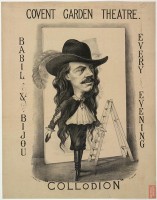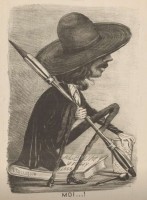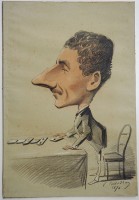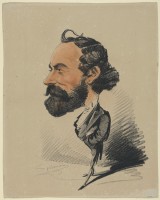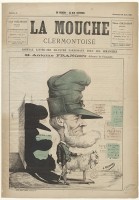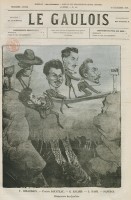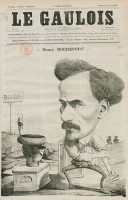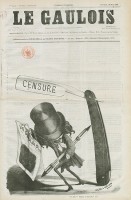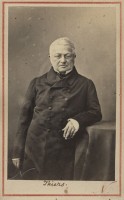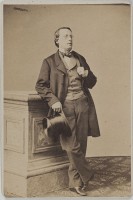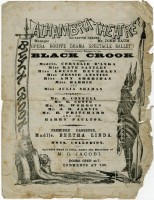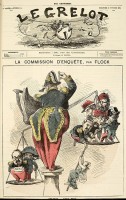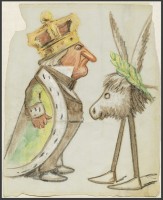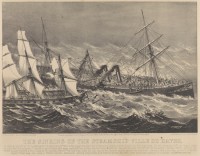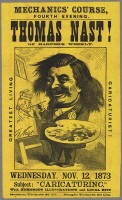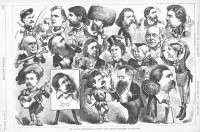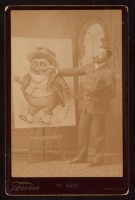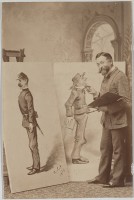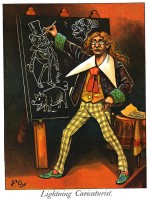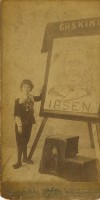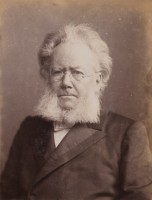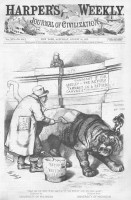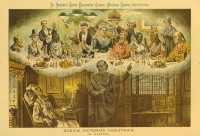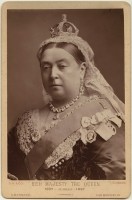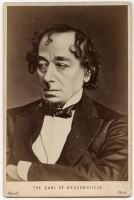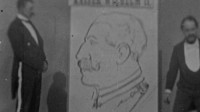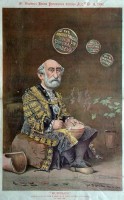The browser will either open the file, download it, or display a dialog.
On the day after Christmas in 1872, a French caricaturist known as Victor Collodion, recently banned in Paris for mocking the president of France, debuted on the London stage. Speaking no English and appearing only momentarily amid a four-hour extravaganza, he became a surprise overnight sensation. A show bill featuring his self-portrait preserves perhaps the sole visual record of his popular act (fig. 1). Garbed in knee-high leather boots, a velvet jacket with diamond-slit sleeves, flaring lace cuffs, and a wide-brimmed hat with a feather plume atop a long mane of flowing hair, Collodion exuded the swashbuckling bravado of an Ancien-Régime guardsman, though armed with drawing charcoal rather than a sword. During each performance, he balanced on a stepladder to scrawl two huge caricatures at breakneck pace, one per side of a twelve-foot-high papered panel. Nimbly dashing off enormous portraits of politicians and celebrities, Collodion caught the public’s fancy, soon inspired a flurry of imitators, and ignited a theatrical craze for rapid-fire caricature.
Before even one year had passed, Collodion’s meteoric career ended in tragedy, but the type of performance he popularized, often called “lightning artist” routines, endured well into the twentieth century as a distinct show-business genre (vid. 1). Adopting myriad professional labels, such as “lightning caricaturist,” “instantaneous cartoonist,” “impromptu artist,” “electric caricaturist,” “express cartoonist,” and “rapid sketch artist,” among others, lightning artists proliferated in many spheres of live entertainment.[1] Especially popular in the anglophone world, with its comparatively tolerant laws regarding political censorship, by the turn of the century lightning-artist acts were common in Australia, Britain, Canada, and the United States. “In England, a drawing act is quite as common as the song and dance,” noted one lightning artist as late as 1922. While in the United States, the same artist observed, the “modern vaudeville manager is keenly alive to the interest in pictures drawn before an audience.”[2]
In addition to their continued popularity on the stage, some lightning artists, a generation after Collodion’s fleeting moment of celebrity, exerted an outsized influence on the nascent cinematic medium of animation. Beginning with the groundbreaking scholarship of Donald Crafton, and more recently with the increased application of performance studies to the early history of animation, scholars in this field have repeatedly observed the profound impact of lightning artists.[3] Thus, in their respective edited volumes from 2019, Scott Curtis writes that “in terms of the conventions or iconography of animation during its early period (1908–1913), the vaudeville lightning sketch is perhaps the most important influence,” and Annabelle Honess Roe notes that even “in later animations that don’t include the act of lightning sketching, the relationship between animation and vaudeville performance is still apparent.”[4]
Film scholars, understandably, have attended more to the influence of lightning artists on early cinematic subjects and techniques than to the origins or prior history of such pictorial and theatrical practices themselves. As a result, lightning artistry has often been treated vaguely as a timeworn stage convention that emerged around the middle of the nineteenth century along with the professionalization of the entertainment formats known as music hall in Britain and vaudeville in the United States.[5] However, the rise of lightning artists does not, in fact, stretch back so far. “It was only in the 1870s and early 1880s that a variety of practices coalesced into the widely recognized ‘lightning cartoon’ music-hall act,” observes Malcolm Cook, whose book Early British Animation: From Page and Stage to Cinema Screen (2018) provides the most thorough and insightful discussion to date of lightning artists in Britain and their involvement with early motion pictures.[6]
This essay describes more precisely the circumstances of that coalescing of practices through a discussion of the seminal, yet overlooked figure of Monsieur Collodion. It also considers the sudden rush of imitators and rivals of Collodion that created an international “sensation” around lightning-artist acts in 1873.[7] Finally, it discusses the reliance of early lightning artists on photographic technologies in the realm of portraiture, especially cartes de visite and cabinet cards. In this way, the essay also seeks to demonstrate how formal influences flowed not only from the tradition of live theater to the deployment of new photographic technologies, but in the opposite direction as well. That is, just as lightning artistry influenced early animation and motion pictures starting in the 1890s, the emergence of lightning artistry itself in the 1870s relied profoundly on developments with the mass visual culture of still photography.
Victor Collodion and the Origins of Lightning Caricature
Artists surely made drawings in front of live audiences before Collodion introduced his unusual lightning-artist act in France around 1871. For centuries, European painters, especially portraitists needing to keep sitters with entourages entertained, had hosted groups in their studios while at work.[8] With the rise of art academies, instructors demonstrated drawing and painting techniques to gatherings of students. However, such situations seem fundamentally distinct from the fast-paced, comical drawing performance Collodion presented onstage nightly to entertain hundreds of paying customers. Intriguingly, the English cartoonist Frank Bellew proposed a similar entertainment in New York in 1861, announcing a public lecture called “Caricature” with the novel feature of being “illustrated by humorous diagrams made at the moment,” but it seems it never materialized.[9] Whatever forerunners may have preceded Collodion in this line, his act prompted a wave of lightning artists and he became, for a brief time, the definitive reference point for such entertainments.
Information about Victor Collodion is scarce. He was born Victor-Alexandre-Louis Malfait in Lille on June 12, 1842. His birth certificate lists his father as a clothmaker, but little else is known about his family or childhood.[10] Accounts differ regarding the location of his upbringing, but several sources suggest that his first professional training came as he pursued “the trade of photographer.”[11] According to one friend, Collodion began work as “an apprentice photographer in Clermont.”[12] Another acquaintance in Saint-Étienne recalled that when Collodion arrived there in 1866, he had retreated from Paris, “where photography seemed not to have enriched him.”[13]
This photographic expertise connects with the presumed meaning of Collodion’s pseudonym. The term “collodion”—derived from the Greek word kollodis, meaning gluey—referred to the syrupy liquid poured onto plate glass to create transparent emulsions that enabled great advances in mid-century photography.[14] Compared to earlier glass-negative techniques, collodion processes yielded crisper images at quicker speeds. Thus the stage name “Collodion” could connote accuracy and rapidity in image making. As one friend noted, Malfait “called himself Collodion, no doubt to better inform the public with what instantaneity he made a portrait likeness.”[15] The full pseudonym “Victor Collodion” might suggest victory over the collodion process itself, perhaps implying something akin to “better and faster than a camera.”[16]
Before turning twenty, Collodion already belonged to a youthful bohemian crowd in Paris orbiting the Théâtre de l’École Lyrique, one of the few théâtres d’élèves, private “training theatres” available for rent, “where young amateurs practice the dramatic profession.”[17] The songwriter Félix Savard chronicled this theatrical institution and its leading figures, noting their fondness for raucous productions as “hilarious and burlesque as possible.” Savard briefly mentions Collodion among the denizens of the humble Café Prud’hom, an establishment near the École Lyrique often packed with garrulous playwrights and aspiring “actors from the provinces” seeking to make reputations in Paris: “At all the tables, in a word, we are talking theater, and in one corner the caricaturist Victor Collodion is making drawings of his neighbors.”[18]
Not merely an onlooker, Collodion also pursued a theatrical career as a singer, lyricist, comedic playwright, and director. In Paris in 1863, he helped organize La Mi-Carême, an annual mid-Lent festival, and in Mâcon in 1865 he published an anthology of comic songs.[19] In 1867, with Savard, he cowrote and codirected a one-act farce with songs, Un crime dans une valise (A crime in a suitcase), at the Théâtre des Folies-Dramatiques, a leading Parisian venue for comic operas and other humorous musical fare.[20] Though an impressive item on his theatrical résumé, this short-lived production probably did little to remedy his financial hardships, described by several acquaintances. One noted that in Paris Collodion grew skilled at sleeping “fully clothed on a mattress on the floor, in the sad, cold, and already cramped bedroom of a broke friend.”[21] Perhaps his precarious economic situation influenced his decision to work largely outside of Paris after 1867. Collodion’s later theatrical productions, largely musical reviews and comical “vaudevilles,” such as Le Parapluie de Monriflard (The umbrella of Monriflard) and La Grande dépêche (The great dispatch), were mounted in provincial cities ranging from Le Mans and Lille, in the north and east, to Bordeaux, Marseille, Nantes, and Tours, in the south and west.[22]
Along with his itinerant theatrical ventures, Collodion also did a brisk business as a portrait caricaturist. After arriving in Saint-Étienne in 1866, he wandered “from café to café, taking portraits by the minute.”[23] By the end of his sojourn, a local newspaper reported that he had established a fixed headquarters at the Café Ombry, charging two-and-a-half francs per caricature.[24] In 1869 in Vichy, where he published a self-caricature (fig. 2), he seems to have heralded his presence at local cafés with a parasol trimmed in pink fabric, which surely made for a distinctive ensemble along with his “brilliant Charles IX–style costume” of black velvet.[25] In some cities, his portrait sessions became a more formal service. In Bordeaux, for example, he opened a studio where he drew caricatures daily from noon until two.[26] A few surviving drawings by Collodion, following the French caricatural convention of big heads on small bodies, exemplify this sort of portrait work (figs. 3, 4).[27]
Collodion also worked extensively as a lithographic artist. By 1864, he was referenced as the “usual draftsman” for the Mâcon lithographer Decourt, who produced all manner of printed materials for local businesses, from theater posters to liquor labels to Franciscan devotional images.[28] However, Collodion’s chief lithographic pursuit soon became journalistic caricature. A friend recalled that the scandalous success of André Gill’s covers for the comic magazine La Lune (The moon), a recurring thorn in the side of the French government, inspired Collodion to work in this vein.[29] Between 1867 and 1872, Collodion designed covers for a string of at least eight different journals, some of which he founded and edited himself.[30] Forbidden by law from deriding government officials and always keeping one foot in the professional theater world, Collodion, not surprisingly, chiefly caricatured performers, musicians, and impresarios.[31]
His first comic pictorial seems to be La Mouche (The fly), published in Clermont starting in the summer of 1867 (fig. 5).[32] A friend recollected that “an adventurous printer” fond of Gill’s work helped Collodion create a journal similar to La Lune.[33] Such endeavors were less common outside of Paris. “What La Mouche is trying is almost unheard of in the provinces, because very few attempts of this kind have managed to succeed,” noted one local paper.[34] Lasting about half a year, the longest of his journalistic endeavors, La Mouche may have been fairly popular, if not lucrative, since it was later remembered as “a little illustrated literary journal, which was much in vogue.”[35] Even La Lune itself took favorable notice of Collodion’s work in La Mouche, ranking him alongside the best of Gill’s Parisian disciples.[36] There is even a possibility that Collodion initially envisioned his provincial journal arranging a formal association with La Lune since, early in its run, Collodion listed Gill among the contributing illustrators.[37]
After La Mouche, Collodion’s lengthiest association with an illustrated journal was with Le Gaulois (The Gaul) in Bordeaux.[38] Here, perhaps for the first time, Collodion ran afoul of the strict French censorship laws. Sensing conflict, or perhaps courting it, in late December he depicted himself with four fellow contributors to Le Gaulois attempting to cross toward the new year of 1869 on a rickety plank without plunging into the “politics” and “defamation” swirling in a dark, ominous chasm beneath them (fig. 6). This picture of the journal’s precarious condition proved prescient.
In the new year, as it grew more brash, Le Gaulois repeatedly ran afoul of the authorities. In early February, officials apparently changed their minds about the acceptability of Collodion’s caricature of Henri Rochefort, a radical playwright and journalist who had recently fled to Belgium to avoid imprisonment and who stood with Gill as a conspicuous critic of the Second Empire regime (fig. 7). After its dissemination, this issue of Le Gaulois was banned from public display—which in turn heightened demand for it and apparently occasioned a second printing.[39] Then, in March, officials denied Collodion permission to publish a caricature of Jules Mirès, the disgraced financier and publisher. In response, for what seems to have been the paper’s swan song, Collodion portrayed himself ducking away from a large razor labeled “censure” looming menacingly above his head, while he holds both an oversized porte-crayon and a blacked-out copy of the journal (fig. 8).[40]
With these provocations, Collodion probably drew further inspiration from Gill, whose caricatures had led to the banning of La Lune in 1868, along with fines and criminal lawsuits against both Gill and his publisher, François Polo, helping to make both men heroes within antiestablishment circles. At least one writer later placed Collodion in this mold of a democratic champion, calling him “a man who had served democracy,” specifically for his work with the journal Le Contribuable (The taxpayer) in Rochefort in 1869.[41] In these years, traveling from city to city, Collodion contributed to local humor sheets for a few months at a time. For instance, he worked with Turlututu (Tra-la-la) in Moulins in the spring of 1868, Bordeaux pour rire (Bordeaux for laughs) in Bordeaux in the spring of 1869, L’Indicateur (The indicator) in Arcachon in the fall of 1869, Le Programme de Vichy (The Vichy program) at some point in 1869, and Le Pilori (The pillory) in Nantes in the fall of 1870.[42] Although Collodion’s frequent moves between cities perhaps suggests a sequence of failed publishing endeavors, it is probably more accurate to view his constantly shifting journalistic endeavors as just one element within a roving and versatile multimedia project rooted in satirical comedy.
Combining these various artistic pursuits, around 1871 Collodion began developing a performance routine in which he drew oversized caricatures of celebrities at high speed. Having apparently honed the act in multiple venues, he brought it to Paris in 1872. The newspaper L’Événement announced his arrival and predicted his success, noting that Collodion, “better known in the provinces than in Paris, will execute in less than fifty seconds an artist’s caricature, double life-size. Le Havre, Bordeaux, Lille, Nantes, and Marseille have already applauded Mr. Victor Collodion, remember this name!”[43]
Arsène Goubert, manager of the Alcazar, a popular café concert in Paris, hired Collodion as part of a variety lineup.[44] In the meantime, Collodion practiced making his caricatures yet larger. One friend recounted how Collodion’s act required “great dexterity and much practice” since, “like a theatrical scene-painter, the executor of such gigantic drawings cannot sense the effect they produce. The nose of his subject is three feet long, the eye is as big as the head of an ordinary man; and then you have to act quickly, very quickly, and not get mixed up.” According to the same source, Goubert paid Collodion “ten francs per evening. What a joy! It was the first success for the poor boy.”[45] Another friend recollected that immediately “the crowd came running” to see Collodion’s unusual routine.[46] But this happy state of affairs did not last long, for a contretemps with government censors abruptly altered Collodion’s career trajectory.
The dispute concerned an alleged caricature of Adolphe Thiers, the president of France, who was also one of Gill’s favorite targets. French law outright forbade the ridicule of public officials. Also, whether published or performed, all caricatures required prior approval from government censors.[47] Although some viewers described Collodion as improvising his caricatures, such an exhibition would have been illegal. Almost certainly, as one acquaintance recalled, “Collodion submitted, ahead of time to the censors, a sketch of the caricatures he wanted to make.”[48] However, on the night of November 8, 1872, Collodion dashed off a drawing that might have departed from his authorized submission. The Parisian theatrical journal Le Figaro closely followed the imbroglio: “The Alcazar is very agitated tonight. Here’s why: an artist named Collodion improvises each evening, on a drawing board, caricatures of familiar comedians. The day before yesterday, after caricaturing some artists, Mr. Collodion ended his session with a portrait of a character whose features a number of people have recognized . . . the president of the Republic.”[49] Accounts differ widely regarding how many patrons interpreted the drawing as Thiers—perhaps the entire audience, perhaps just one killjoy policeman.[50] Either way, according to Le Figaro, the incident was “reported through government channels to the Prefect of Police” with the result that “the Alcazar has been ordered shut for eight days.”[51]
Goubert and Collodion quickly protested that “the incriminating caricature was intended to represent the features of the actor Léonce” rather than the French president.[52] Any confusion resulted, they claimed, from the fact that the tenor Léonce, famous for his comical roles in Jacques Offenbach’s opéra bouffe productions, wore small-lensed, wire-framed glasses quite similar to those of Thiers (figs. 9, 10). “Faced with these denials, the administration has paused; it has ordered an investigation,” Le Figaro explained.[53] In the end, the authorities pardoned Goubert and the Alcazar, which quickly reopened, but held the artist culpable. Collodion was henceforth banned from public performances in Paris.[54] Le Figaro reported ruefully that “Collodion no longer has authorization to make any kind of caricature in public. All because Léonce has the misfortune to wear glasses!”[55]
The Lightning-Artist Craze of 1873
Perhaps an impulsive gaffe, perhaps a misinterpreted drawing, perhaps a deliberate provocation, Collodion’s fateful caricature—whether depicting Léonce or Thiers—stifled his professional prospects in Paris but, simultaneously and unexpectedly, it also opened new opportunities elsewhere. As one London journalist noted, after learning that Collodion “was very recently prohibited from performing in Paris,” it was only natural that in England “everybody will be curious to see an exhibition of his unique skill.”[56] Capitalizing on his sudden notoriety, Collodion quickly achieved success in England far greater than he could have imagined. With the French manager Bernard Latte facilitating the engagement, the actor-playwright Dion Boucicault soon added Collodion to his current show, Babil and Bijou, a five-act “mammoth spectacle” that offered a rich musical score, lavish costumes, and impressive scenic effects, which transported viewers to fairyland, the ocean floor, the moon, and elsewhere.[57]
Although incongruously shoehorned into this production, Collodion’s caricature routine quickly became a star turn (fig. 1). A writer for the London Daily News described Collodion’s enigmatic appearance: “Amongst the many curious incidents which arise in the course of this adventure is the sudden appearance upon the stage of a M. Collodion, who, without any apparent provocation or reason explicable in connection with the story, proceeds to draw in chalk on a large board a caricature likeness of M. Thiers.”[58] For those aware of Collodion’s recent suppression in Paris, his performance surely held added significance, perhaps offering a transgressive thrill from witnessing a forbidden performance, perhaps reinforcing a smugly nationalistic sense of superiority over France. But even without such associations, and without a compelling narrative purpose for Collodion within the show, audiences enjoyed seeing the huge caricatures drawn in furious bursts of activity. Declaring it “one of the most astounding performances I ever saw in my life,” the editor of London’s comic journal Judy described how Collodion “with a piece of black chalk on a white board, sketches with the greatest rapidity, and without a false stroke, a series of caricatures of popular characters.”[59] A writer for the Morning Post reported that Collodion’s drawings repeatedly “awoke shouts of laughter” while mystifying his viewers.[60]
A French visitor to London detailed Collodion’s “superb” routine: “Two assistants brought a large white frame, four meters high by two meters wide, and placed it center stage; another appeared bringing a stepladder.” Then, from the wings, “boldly crossing the vast scene,” Collodion entered, wearing a “soft felt hat with a wide brim, velvet jacket, hussar pants. He climbed the stepladder, holding in his hand a piece of black pastel, as big as an apple.” Collodion set to work abruptly, “crushing his pastel on the canvas, punching with his fists,” and in under two minutes he had produced a large caricature of Prime Minster Gladstone. After his assistants swiveled the frame, Collodion dove into another frenzy of gesticulation, rendering a caricature of the radical trade unionist George Odger. In mere minutes, the routine ended and Collodion “greeted the audience graciously and went backstage.”[61]
On New Year’s Eve, just a week after his debut, Collodion corresponded with a friend in Paris, excitedly sharing news of his enthusiastic reception and his suddenly exorbitant salary. “As for me, I have an immense success at the royal theatre at Covent Garden in Babil and Bijou,” he wrote. “So, my commitment was extended to March 10, when I will go to the Manchester Theater for six weeks for 10,000 francs (!!!) What do you say about the English, hmm?”[62] Collodion’s Manchester contract paid over twenty times more per week than the wages he had briefly earned in Paris at the Alcazar. In addition to this enormous pay raise, Collodion surely enjoyed the lax attitude of the English authorities toward caricaturing government figures; he regularly drew Prime Minister Gladstone and other English politicians. Beyond the reach of French censors, he was also free to repeatedly caricature Thiers, making something of a signature piece from the subject that—deliberately or not—had stirred up such trouble in Paris.
Thus, Collodion began 1873 on a high note, but in the coming months the craze for lightning artistry he had launched spurred rival acts onto the stage. Artists, performers, and theatrical managers rushed to capitalize on the new fad. Shortly after Collodion reached Manchester, he encountered perhaps the first of many imitators, presumably a parodist, advertised as “Signor Cyanide de Potassium.” Since potassium cyanide was used to fix, or neutralize, the wet-collodion development process, this nom de guerre suggested an implicit, if comical, challenge to Collodion.[63] More threateningly, by the end of March a true rival, known as Signor Kalulu, had appeared with a lightning-caricature routine in London’s Marylebone Music Hall as part of a minstrel show organized by Holmes & Gant, who quipped in their advertisements that the troupe would “make no use of ‘Collodion’ in their portraits.”[64]
Returning to London in April, Collodion’s popularity grew, as did the number of his imitators. Starting on Easter Monday, he appeared for three months in the city’s reigning “spectacle par excellence,” Black Crook, one of the “big spectacular musical shows” for which the cavernous Alhambra Theatre was then known (fig. 11).[65] Rather than wearing out his welcome, Collodion—now often billed as “The Great Collodion” rather than simply “Monsieur Collodion”—further burnished his reputation. “The celebrated M. Collodion . . . seems to have gained in popularity since his first appearance at Easter, and to have surpassed his former efforts at Covent-garden,” noted The Era, the leading chronicler of the London stage. “He proves to be a great attraction, and is hailed with enthusiasm nightly by crowded audiences.”[66] Indicating the growing familiarity of his routine, during that summer at least two London theaters mounted mock caricature performances that spoofed Collodion’s distinctive act.[67]
In mid-July, Collodion left Black Crook a few weeks before it closed, in order to return to Paris, where on July 26 he married a young singer from Lyon named Françoise Bertillot.[68] These nuptials help explain both his departure from London despite his ongoing success, as well as his late arrival for his next contracted engagement with Lydia Thompson’s English burlesque troupe at the Olympic Theatre in New York. The New York Times noted that Thompson’s upcoming production, Mephisto and the Four Sensations, would feature some specialty acts, “and most important among these will be, it is understood, the instantaneous caricatures of M. Collodion.”[69] However, Collodion did not reach Manhattan in time for his scheduled debut, much to the chagrin of Thompson’s manager, who published apologetic notices promising Collodion’s imminent arrival. Mr. and Mrs. Collodion—the press seems to have never used their legal names—finally reached Manhattan at the end of August, with Collodion joining the cast of Mephisto one week into its slightly postponed run.[70]
This short delay proved immensely costly, for Collodion no longer had the field of lightning artistry to himself. Before he had reached New York, a daunting competitor, as opposed to a clowning imitator, had taken to the stage of a prominent theater—though the details of precisely what transpired remain unclear. Perhaps first attempting to hire Collodion himself, the New York theatrical producer Henry Palmer, either knowingly or unknowingly, instead signed a different French artist living in London, Félix Régamey, to perform lightning sketches in a revival production of the much-imitated blockbuster The Black Crook.[71]
Like Collodion, Régamey had designed caricatures for short-lived, liberal humor magazines before moving to London as a political outcast from Paris. Régamey had been one of the artists working closely with Gill and contributing to La Lune; Régamey and Gill shared credit for a drawing in the magazine as early as 1866.[72] Régamey remained in the French capital as an enlisted soldier through the turbulent months of the Paris Commune. In 1871, he briefly published caricatures in Le Grelot (The bell), sharing the pseudonym “Flock” with Gill, another staunch communard (fig. 12).[73] At some point after the Commune fell, Régamey departed for London, where he had already been getting work by sending sketches to the Illustrated London News.[74] Though he departed Paris before Collodion’s performances at the Alcazar, Régamey may well have witnessed Collodion’s routine in London at either Covent Garden or the Alhambra Theatre.
It is hard to escape the conclusion that Régamey’s promoters in the United States deliberately misrepresented him to the public by conflating him with Collodion, though understandably confused journalists surely compounded this skullduggery.[75] Régamey was trumpeted from Boston to San Francisco as “the French caricaturist, who astonished London during the run there of ‘Babil and Bijou.’”[76] The Minneapolis Tribune recounted the tale of the transgressive depiction of Thiers at the Alcazar in Paris, but mistakenly identified Régamey as the perpetrator.[77] Sam Colville, manager of Thompson’s Troupe, attempted to set the record straight with advertisements calling Collodion “the Original Caricaturist” and asserting his credentials as “the only acknowledged artist of his character of art known in Europe, all others being imitators.”[78] Not surprisingly, hard feelings arose between the two artists. “Rivalry ran high between them, and Collodion charged Régamey with abridging his labors,” noted the World.[79] Régamey’s promoters tried to shift the debate away from artistic precedents by challenging Collodion to meet Régamey publicly in a lightning-caricature contest for bragging rights along with a sizeable prize purse, insisting “that Collodion’s friends shall either put up or shut up.”[80] Apparently no such faceoff transpired, but a war of words continued as it was “hinted by the Collodion side that M. Régamey has his pictures all carefully traced on the paper” before each performance.[81] Soon, however, adding insult to injury, the Thompson Troupe parted ways with Collodion and added a spoof version of his act to their burlesque production Aladdin.[82]
Régamey was not the only rival caricaturist to perform that fall. In Philadelphia, three weeks after Collodion arrived in New York, the impresario Robert Fox debuted another French lightning artist, Edward Jump, a caricaturist long residing in San Francisco who had moved east to work as a newspaper illustrator.[83] “The latest thing upon which theatres have seized is the caricaturist,” observed the World. “There are now three of these sketchers nightly working for amazed audiences at three of our theaters.”[84] Rumors of a fourth lightning artist, “a poor, uneducated Irish boy,” reached the Evening Telegraph, which reported that the young artist “attracts much attention in the streets and barrooms by his talent from crayon sketching.”[85] This was probably Henry or James Carling, immigrant orphan brothers from Liverpool, of Irish parentage, who supported themselves as sidewalk chalk artists.[86] Before the month of September 1873 was over, P. T. Barnum, never one to ignore a popular fad, had “engaged an English artist named Howe to run an opposition to Messrs. Regamy [sic] and Collodion in the fast-color school of portraiture.”[87]
With his New York reception largely spoiled through the marketing machinations of Palmer, Collodion quickly accepted an offer to perform in Cincinnati with The Magic Talisman, a production “just about as near to the ‘Black Crook’ as it can well be, and yet be changed at all.”[88] Claiming to be the “grandest exhibition ever presented outside of New York City,” the show paid well from its lavish budget.[89] Unlike Manhattan, Cincinnati received Collodion with open arms. Each morning, newspapers chronicled his caricatures from the previous night’s performance. From nationally known celebrities to local figures ranging from the mayor to the chief coroner, Collodion’s caricatures enthralled his midwestern audiences.[90] “He produces immense portraits of people in the audience and of prominent people, on a huge blackboard, in one minute and a half. His work creates great enthusiasm everywhere,” noted the Cincinnati Enquirer.[91]
As Collodion entertained in Ohio and Régamey continued to perform in New York, still another illustrator, destined for the greatest success that season as a lightning artist in the United States, prepared to introduce yet another sketch act. Debuting on October 6, 1873, in Peabody, Massachusetts, Thomas Nast, the radical Republican caricaturist for Harper’s Weekly, toured the Northeast and Midwest, lecturing for half a year on the lyceum circuit.[92] Advertisements for Nast’s tour promoted him both as a combative editorial cartoonist as well as a novel lightning artist in the mold of Collodion. Nast’s performance was described as part of a brand new fad, “a just found art, at least in this country,” one advertisement announced. “This ‘instantaneous caricature’ is a comparatively ‘new thing,’—somewhat of a ‘sensation.’”[93] Whereas Collodion and most of his imitators presented short routines within larger theatrical spectacles or variety bills and greatly emphasized the speed of their depictions, Nast had an entire solo performance to fill and, while he did work quickly, he also added more details to his drawings. “He makes of the hurried caricatures, not mere outline sketches, as Régamey and Collodion did, but tinted and neatly finished pictures in colored chalks,” reported the Evening Post.[94]
Although lyceum audiences generally came to hear famous speakers, Nast was different; the public wished above all to watch him draw. A typical reaction came from Alexander Graham Bell, who witnessed Nast’s act in October and described the performance in a letter to his parents: “He did not speak much but illustrated his subject by actually creating Caricature before our eyes. A large square frame about seven feet high, containing enormous sheets of paper, was placed, like a black-board on the platform. He would slash away at this with coloured crayons—as rapidly as if he were whipping an animal—and in little more than a minute would produce a wonderfully perfect life-size caricature of some well-known man. His power with the crayon was perfectly astonishing.”[95] A rare surviving drawing from Nast’s tour, now in the National Portrait Gallery, mocks the former president, Andrew Johnson, for tyrannical tendencies (fig. 13).[96]
After finishing his theatrical run in Cincinnati, Collodion returned to Manhattan, where he probably encountered advertisements announcing Nast’s upcoming, sold-out performances at Steinway Hall.[97] Collodion considered establishing a studio, both to make comical portraits and to train other caricaturists, but amid the depressed economic conditions following the Panic of 1873, the timing likely seemed inopportune.[98] Thus, Collodion and his wife secured a dockside booking aboard the large steamship Ville du Havre bound for France, which set to sea on November 15—and never reached land. After one week on the ocean, at two in the morning on November 22, the Ville du Havre collided with the Scottish clipper Loch Earn in one of the worst naval disasters of the nineteenth century (fig. 14). Newspapers across the globe described the horrific incident, based on the accounts of survivors. “When the crash came, in the darkness of the night, it broke clear through one side of the steamer, killing passengers in their berths, and bringing with it a deluge of water that rapidly filled the hold,” explained Harper’s Weekly. “The deck was soon thronged with startled passengers; but many, paralyzed with terror, remained in their state-rooms and perished without making an effort to escape their too certain doom. Thirty or forty passengers succeeded in getting into the long-boat and were ready for launching when suddenly the mizzen-mast fell over and crushed many of them to death.”[99] Most of the 313 passengers and crew perished in the cold, North Atlantic waters, including both Mr. and Mrs. Collodion, Victor and Françoise Malfait. The newlyweds had been married less than four months. Fewer than eleven months had elapsed since Collodion’s London debut had launched his whirlwind success. He was thirty-one. She was twenty-six.[100]
Collodion was gone, but lightning caricature continued to flourish as Nast and Régamey toured the United States, both drawing large crowds (fig. 15).[101] When the popular English comedian William Horace Lingard, famous for his celebrity impersonations, toured the United States that winter, his act included both an homage to Collodion and an imitation of Nast.[102] Nast earned a windfall from his heavily booked lecture tour, garnering the second-highest advanced ticket sales that season among the dozens of lecturers on the premier lyceum circuit run by James Redpath.[103] Touting the success of their prominent artist, Harper’s Weekly published a full-page illustration of the season’s “Popular Lecturers,” conspicuously featuring Nast in the front ranks beside his friend Mark Twain (fig. 16). Nast disliked the wearisome experience of lyceum touring, crisscrossing the United States on a relentless travel schedule calculated to maximize performances and ticket sales. After earning far more than he or Redpath had expected, and greatly missing his family, Nast abruptly ended his tour several weeks early and returned to his home in Morristown, New Jersey. Though cajoled by Redpath and others to return to the lecture stage, he declined for over a decade. However, after a series of ill-fated investments left him badly strapped for cash, Nast returned to the lyceum circuit in the late 1880s (figs. 17, 18).[104]
Just as in the United States, talented successors to Collodion had already emerged back in Britain by the time of his death. Building on the positive reception of a newly honed routine performed in Blackpool and other venues in the fall of 1873, Signor Kalulu began touring England, performing “in the manner” of Collodion, making rapid caricatures of celebrities “five times the size of life.”[105] At first, Kalulu acknowledged his obvious debt by advertising himself as “the Eminent Caricaturist, a la Collodion.”[106] However, Collodion’s fleeting career soon began fading from memory, supplanted by other caricaturists and cartoonists, who often added unique twists to the novel routine he had first popularized. By 1877, a reviewer in Derbyshire described sketches by a new lightning artist as “drawn à la Kalulu” rather than à la Collodion.[107] Gaining further notice from caricatures appearing regularly in The Hornet magazine, Kalulu had become the new touchstone for English lightning artistry.[108] Kalulu was the only stage caricaturist mentioned in the 1876 edition of The Era Almanack stage directory, but by then he already faced competition.[109] By January 1875, Tom Merry was performing in a London variety theater.[110] Another prolific lightning artist, “the Express Cartoonist, Edgar Austin,” was appearing at the Bow Music Hall in London by February 1877.[111]
Within just a few years, the professional calling of the lightning artist had become familiar even in rural areas, such as small towns in the western United States, as demonstrated by the peculiar case of Eugene Lippincott. An itinerant “lightning-sketch artist,” Lippincott traveled in the summer of 1878 on foot through California from Vallejo to Crescent City, where he was mistakenly apprehended under suspicion of murder. Newspapers reported that, after he was escorted by sheriffs to San Francisco, “in proof of his artistic ability, he has, within the brief period of his incarceration in the City Prison, ornamented the walls of his cell with a well-executed full-length sketch of a burlesque actress of a most pronounced type.” Luckily for him, after further scrutiny, Lippincott’s height, long mustache, and absence of scars on his nose helped establish his innocence.[112]
By 1885, Frederick Burr Opper’s illustrated book of children’s poems, A Museum of Wonders, included the lightning caricaturist among the categories of typical dime-museum entertainers, such as the magician, sharpshooter, silhouette cutter, ventriloquist, learned pig, phrenologist, and others (fig. 19).[113] With no need for scenery or complex staging, lightning artists easily adapted to any performance space. Thus, along with all manner of dancers, singers, illusionists, musicians, comedians, contortionists, acrobats, puppeteers, animal trainers, and so forth, the lightning artist became a fixture of the sideshow, circus tent, minstrel troupe, cabaret club, and, above all, variety theatre. By the turn of the century, over one hundred performers continued along the trail Collodion had blazed, on both sides of the Atlantic.[114]
Photographic Memories
The breakout success of lightning caricature in the 1870s relied on the visual mass culture established the previous decade with the abrupt proliferation of cartes de visite. Forerunners to various trading cards and other photographic collectibles, cartes de visite offered small images mounted on cardstock, enabling the first affordable mass distribution of photographs, especially portrait likenesses. Patented in 1854, cartes de visite rocketed to popularity around 1859 in Paris and soon caught on in London, New York, and other cities.[115]
Andrew Wynter, a prominent Victorian physician and cultural critic, described what he termed “the carte de visite mania” or “rage.”[116] An extensive market, he noted, “has sprung up with amazing rapidity,” with inexpensive photographic likenesses suddenly saturating the public sphere. “Wherever in our fashionable streets we see a crowd congregated before a shop window, there for certain a like number of notabilities are staring back at the crowd in the shape of cartes de visite.” Despite such urban spectacles, the vast scale of this novel pictorial business was not immediately obvious. “The public are little aware of the enormous sale of the cartes de visite of celebrated persons. An order will be given by a wholesale house for 10,000 of one individual.” Highly sought-after images circulated in far greater quantities. “Her Majesty’s portraits, which Mr. Mayall alone has taken, sell by the 100,000.” In sum, the abrupt “universality of the carte de visite portrait has had the effect of making the public thoroughly acquainted with all its remarkable men,” so far as appearances went.[117]
In several important ways, cartes de visite differed from the slightly earlier mass visual culture supplied by pictorial reportage in the illustrated press. Newspaper images, sometimes adapted from photographs but necessarily reproduced as woodblock engravings or lithographs, could be clipped and pasted into scrapbooks. Cartes de visite, on the other hand, offered true photographic prints, manufactured with standard dimensions and printed on high-quality paper, that were marketed expressly for inclusion within albums designed for their careful arrangement and display. Unlike ephemeral newspaper imagery, cartes de visite were meant to be collected, savored, studied, and rearranged.
Neuroscientific research has demonstrated the impressive capacity of the human brain for facial recognition, but such abilities were already intuited in the nineteenth century as viewers pored over portrait photographs. “Even the cartes de visite of comparatively unknown persons so completely picture their appearance, that when we meet the originals we seem to have some acquaintance with them. ‘I know that face, somehow,’ is the instinctive cogitation,” wrote Wynter.[118] Lightning caricature, initially the most common form of lightning artistry, profoundly relied on these new pictorial reservoirs of portraiture kept in mind by a visually sophisticated public thoroughly steeped in celebrity imagery. Though some intrepid lightning artists—including Collodion and Kalulu—sometimes caricatured audience members off the cuff, routines commonly featured only famous faces.[119] Quickly communicating a recognizable likeness with the fewest strokes possible hinged on the audience’s familiarity with specific widely circulated portraits. Although embellished with theatrical showmanship, both athletic and illusionistic, as a popular phenomenon lightning caricature constituted an encounter with the newly experienced condition of a mass visual culture consisting of cheap, widespread, iconic photographic portraiture.
Amid the flood of cartes de visite, reporters often referenced these widely circulating likenesses as a convenient shortcut past written descriptions, thereby also offering readers, still growing accustomed to torrents of photographic portraiture, reassurance about their visual credibility. For a public fascinated with physiognomy to the point of seeking character traits through the phrenological analysis of physical appearances, the mechanical objectivity of photographic portraiture offered compellingly pertinent visual information, especially regarding political leaders entrusted with public affairs. Thus, in the 1860s comments about the concordance—or sometimes discrepancy—between scrutinized studio portraits of notable persons and their witnessed appearances in public became a recurring journalistic trope. For instance, after the photographer John Jabez Edwin Mayall released a portrait of Lord Derby, leader of the Conservative Party, a London correspondent who glimpsed the politician at a Horticultural Society fête vouched that he indeed looked “marvellously like Mayall’s unrivalled portrait.”[120]
In the United States, where cartes de visite became fashionable as the Civil War commenced, northern newspapermen validated photographic portraits of Union military officers, many of whom had not otherwise been before the public eye. The Washington correspondent for the Chicago Tribune assured readers that Major Anderson “looks just like his pictures” and a Wisconsin war correspondent noted that General Burnside “looks as near like his pictures as can well be.”[121] After the war, the Washington correspondent for the San Francisco Examiner described his first sighting of President Ulysses Grant, remarking, “I had a good chance to observe his personal appearance. He looks just like his photograph likenesses, and it was by having seen them that I knew it was him.”[122] Significantly, such comments assumed a reading public thoroughly familiar with specific portraits, an assumption that would not have been blithely made a decade earlier.
By 1870, with celebrity portraiture only growing more popular as the larger format of cabinet cards began supplanting cartes de visite, the prominent Cincinnati newspaper editor Murat Halstead (one of Collodion’s first caricature targets when he performed in Ohio) commented that “the question that every one now asks about a celebrity” had become, “Does he look like his photographs?”[123] Meanwhile, celebrities could feel pressure to keep their appearance in conformance with circulating images. In 1867, the author William T. Adams joked about strictly preserving his resemblance to a published portrait, praising his barber for the “perfect” maintenance of his whiskers “for the sole purpose of looking like his picture.”[124] Such visual congruency could never be taken for granted, as Halstead explained with regard to his eyewitness interactions with another world leader, Otto von Bismarck. “You might look at all the photographs of Bismarck that are to be seen, and all the engravings and prints, and then you would not know him in the street.”[125] Rather than impugning the accuracy of photographic portraiture, Halstead here called attention to the physical changes wrought by aging as opposed to the timelessness of iconic likenesses that could persist in both the image marketplace and the public memory.
The profound reliance of lightning caricaturists on such commercial portraiture arose explicitly in a Pall Mall Gazette reporter’s interview with “Little Erskine,” already a noted lightning caricaturist at the tender age of ten. “Could you make a likeness of me?,” the journalist inquired, while visiting Erskine Williams at home. “Yes, I think so. But I’d rather make it from a photograph,” the young artist tellingly replied. Erskine’s mother then interjected “that up to the present he had not had much practice at drawing from nature.”[126] Erskine’s diary corroborates that he sought out portrait photographs of local subjects when performing in new cities.[127] A surviving Viennese cabinet card shows Erskine, proudly festooned with medals received from various music-hall managers, standing beside his stepstool and easel, which displays a sketch of the playwright Henrik Ibsen corresponding to a contemporaneous studio portrait by Julius Cornelius Schaarwächter (figs. 20, 21).[128]
A 1910 instruction manual for budding lightning artists underscored the central role of photography in crafting recognizable caricatures. Step one required directly converting a familiar photograph into a painstakingly simplified design: “Let the young cartoonist first procure a pronouncedly good photograph, in profile preferably, and copy this in detail, gradually omitting half tones or shadings until the likeness is apparent when only the minimum of strokes is used.” Step two involved rote practice to develop muscle memory for the sketch through repetition. The instructions recommended that “the outlines should be drawn again and again until the hand has become so accustomed to the correct presentation of the portrait that it can draw it off in a second or two.”[129] Having initially trained as a photographer, Collodion too apparently derived his lightning caricatures directly from photographs, as one friend recalled. “It was not caricature, but simple magnification; he would take a photograph, amplify it, and that would be it.”[130]
Not surprisingly, some caricaturists amassed large collections of celebrity portraits. Thomas Nast’s studio contained a vast and growing assortment, as the Evening Post described just before the artist’s 1873 lyceum tour. “A cabinet contains the photographs of nearly every important personage in this country and abroad,” noted the reporter, adding that Nast used an index to find specific portraits quickly from among thousands.[131] The previous year, Nast satirically skewered Benjamin Gratz Brown, the Democratic nominee for vice president, by repeatedly portraying him as merely a tag affixed to presidential nominee Horace Greeley’s ample coat, a comical visual conceit that implied Brown’s insignificance but that arose as a practical solution when Nast could not locate a photograph of the former Missouri senator (fig. 22).[132] Joseph Keppler, who came to prominence drawing political caricatures around the same time, kept “an astonishingly large collection of pictorial clippings” from the illustrated press.[133] Keppler’s image collection eventually filled an entire library, which he made available to his staff artists at the headquarters of his humor magazine Puck. Some caricaturists, such as Harry Furniss, disdained an overreliance on photography, but even he acknowledged that “if he has to draw a man for some special reason, and has not seen him, a photograph is, of course, the only means possible.”[134]
Conspicuous borrowings by caricaturists sometimes irked portrait photographers. In 1886, for instance, photographer Alexander Bassano threatened to sue Tom Merry for copyright infringement of the jubilee portrait of Queen Victoria, allegedly copied in Merry’s cartoon Queen Victoria’s Christmas published in the conservative humor magazine St. Stephen’s Review (figs. 23, 24). The matching crown, jewelry, sash, and dress, along with the identical pose, suggest that Merry surely did refer to the photograph—and understandably so since Bassano’s royal portrait was current and familiar. More surprising is the failure of the newspaper that reported the threatened lawsuit to notice the obvious similarity. Instead, the paper shrugged off the very idea that Merry might consult a photograph. “Considering that Mr. Merry first obtained fame as ‘lightning’ caricaturist at the Aquarium and throughout America, he is little likely to require the assistance of a photograph to enable him to sketch so well known a face as that of Her Majesty.”[135]
Even when caricaturists had no need to rely on specific photographs, adhering closely to the appearance of widespread likenesses could provide surefire visual cues for viewers. Perusing the illustrated satires of Merry, Nast, Keppler, and other contemporary political caricaturists reveals their frequent reliance on mass-circulated portraiture. For example, in the same cartoon that Bassano decried, Merry also presented the deceased prime minister Benjamin Disraeli as a ghostly presence by adapting an iconic cabinet card circulated by Mayall around 1868 (fig. 25).[136] By carefully altering photographic portraits and integrating them into imagined scenes, direct borrowing could easily go unnoticed by the general public. Yet, when viewing many of the same subjects in rapid succession, as happened with a traveling magic-lantern show of sixty caricatures by Merry from St. Stephen’s Review, audiences sometimes detected the repetition of facial imagery. “We get the same faces on different bodies, and in different attire in every picture,” noted one writer for the Islington Gazette.[137] However, even as lightning artists drew imitations of specific photographs, during their fast-paced stage routines most viewers probably failed to perceive the correspondence, especially since the hastily scrawled imagery from the hand of an artist seemed far removed from the detailed and mechanical perfection of the camera.
The extent to which Merry actively participated in the planning, production, and performance of the magic-lantern amusements built around his St. Stephen’s Review cartoons is unclear. However, whether deliberately or serendipitously, by 1895 his drawings again became involved with novel entertainment formats rooted in new technologies of vision, namely the peephole kinetoscope and then motion pictures projected on screens. In this way, Merry became perhaps the first, if not the most influential or prolific, of several professional lightning artists to contribute to the early experimental phase of cinema and animation. More than this, even if his participation was solely limited to appearing in several short reels, this alone has established him in the annals of British cinema as the earliest performer familiar to the general public to appear in motion pictures, thereby earning him the description as Britain’s first “film star.”[138] Further, his lightning-caricature films are routinely taken as the first known instances of British animation, though only several seconds from the end of one of his performances is known to survive (figs. 26, 27).[139]
Lightning Caught on Film
When Merry recorded his first known lightning-artist films in 1895, his finances had recently hit rock bottom. He had owned a one-third share of a theatrical trade paper, The Music Hall and Theatre Review, but it was sold at a loss in 1892.[140] His steady employment with St. Stephen’s Review came to a halt when that journal, after first attempting to reinvent itself under the title Big Ben, ceased publication in 1893. Making matters worse, these setbacks coincided with the last cyclical fluctuation of the so-called “long depression” of the late nineteenth century in Britain, with an economic boom in 1890 quickly descending into a financial recession in 1893.[141]
The success of St. Stephen’s Review abruptly turned to failing fortunes, costing Merry dearly in the process. According to its editor, William Allison, the parliamentary general election of 1886 “brought St. Stephen’s Review to the zenith of its prosperity.”[142] While the magazine routinely sold over 10,000 copies per week, the business for its weekly color-lithograph cartoons, which sold more copies separately than with the journal, reached far vaster circulations. The cartoons sometimes “went by hundreds of thousands. Tom Merry could not print them fast enough, and other lithograph firms had to assist.”[143] Unexpectedly, however, in 1890 the magazine fell into a quarrel with the newly formed Hansard Publishing Union, a company that controlled much of London’s printing and papermaking trades. A minor squabble escalated through threats and lawsuits, with formal allegations of libel eventually leveled against both sides. Merry’s cartoon Bubbles (fig. 28), a punning parody of a famous Pears Soap advertisement that reproduced a painting by John Everett Millais, comes from the early phase of this quarrel. It depicts the Lord Mayor of London blowing financial bubbles rather than soap bubbles—that is, creating overpriced stock assets, the largest of which is labeled “Hansard Publishing Union.” With each party feeling unfairly aggrieved, both continued along an escalating “warpath,” with the unnecessary conflict eventually leading to mutual destruction. The magazine undermined public trust in the publishing combine, while the publishers successfully pressured booksellers across London to boycott the magazine. Both went bankrupt, as did Merry, who was owed £320, presumably for unpaid printing bills, by the magazine when it folded. After personal loans ran dry and his liabilities caught up to him, Merry spent time in debtors’ prison in 1895, appeared in bankruptcy court in 1896, and died in 1902 before turning fifty.[144]
After these financial reversals with his publishing concerns, Merry returned to treading the boards with his lightning-caricature routine in an attempt to find gainful employment—and this, in turn, led to his involvement with early motion pictures. At some point in 1895, Merry recorded two short films for Birt Acres and R. W. Paul, leading innovators of the motion-picture industry in Britain who briefly worked in partnership. These two films, showing Merry making lightning sketches of German leaders Kaiser Wilhelm II (fig. 27) and Otto von Bismarck, were created for display in peephole viewers akin to the kinetoscope devices manufactured by Thomas Edison.[145] But both films were subsequently included in Paul’s watershed screening of projected motion pictures in March 1896 at the Alhambra Theatre—the same venue, though rebuilt after a fire, where Collodion had performed in Black Crook years earlier. After dissolving his business with Paul, in 1896 Acres recorded two additional short films of Merry making lightning caricatures of the British prime ministers William Gladstone and Lord Salisbury.[146] These two films were projected by Acres at Marlborough House in July 1896 as part of his royal-command film presentation.[147] Thus, short films of Merry appeared in both of the landmark screenings of early motion pictures in Britain.
With snappy, topical, and visually intriguing routines at the ready, lightning artists offered ideal content for early cinematic entertainment. Accustomed to making images visible to large audiences, their work translated easily and legibly to film. In addition, their performances had qualities nicely suited to the technical limitations of primitive motion-picture cameras. For instance, lightning artists created high-contrast images, generally working either with black ink or charcoal on light paper or with white chalk on dark slate, thereby allowing maximum clarity in photographic exposures. While their routines involved motion, activity tended to stay within neatly bounded areas, simplifying the placement of lone stationary cameras. In addition, lightning artists typically remained quite near the plane of their drawing surfaces, thereby dispensing with any need to change focus on camera lenses. At least one early film of a lightning-artist performance, seemingly a music-hall routine staged for the camera around 1900, survives in the British Pathé collection (vid. 1).[148]
Though there is no evidence that Merry participated in filmmaking beyond performing for the camera, in exactly these years other professional lightning artists began creating motion pictures.[149] In New York, the English expat J. Stuart Blackton, who performed as a lightning artist under the stage moniker “The Komikal Kartoonist,” was filmed at Edison’s studio in 1896 making a lightning caricature of the famous inventor. Soon thereafter, struck by the potential of the new medium, along with his friend and fellow performer, the stage magician Albert E. Smith, Blackton founded Vitagraph Studios, which grew into a leading producer of movies of the silent era.[150] Going beyond simple footage of his lightning-artist routine, in The Enchanted Drawing from 1900 (vid. 2), an early trick film made in the United States, Blackton appears as a lightning artist whose hastily depicted objects—a bottle, wineglass, hat, and cigar—have the added special effect of jumping off his tablet into three-dimensional space through the use of stop-motion substitution, a technique he and Smith frequently employed and even contemplated trying to patent.[151]
Also in 1896, the French pioneer of trick films, Georges Méliès, began his film studio in Paris (purchasing his first camera equipment from Paul) and immediately adapted lightning artistry into his cinematic repertoire.[152] Among the short films made during his first season, Méliès recorded at least four short lightning-sketch reels that he called Dessinateurs (Drawings), all now presumed lost, in which an artist—probably Méliès himself—drew caricatures at high speed. His subjects included the former German chancellor Otto von Bismarck, as Merry had done the year before, along with two English subjects, Queen Victoria and the politician Joseph Chamberlain. But the very first of Méliès’s lightning sketches depicted Adolphe Thiers. Given that Thiers had died nearly two decades earlier and was thus a decidedly less topical selection than the other three, it is tempting to interpret this choice of subject as a conscious homage, or perhaps an unintentional echo, referring to the controversial lightning sketch drawn by Collodion at the Alcazar in 1872. At that time, news of Collodion’s provocative act might even have reached Méliès, who was then nearly eleven, living in Paris, and already fascinated by drawing and stage mechanics.[153] Though only written descriptions of Méliès’s 1896 Dessinateurs survive, later films in which he utilized lightning artistry do exist, such as La Roi du maquillage (The Untamable Whiskers) from 1904, in which Méliès rapidly draws various hirsute portraits, transforming himself into approximations of each using makeup and long dissolves (vid. 3).
Meanwhile, in London in 1899, Paul hired the lightning artist and ventriloquist Walter Booth, an underappreciated figure in cinematic history, to create films for his production company. Booth surely acquired familiarity with motion pictures while performing as a lightning artist during intervals between short film screenings, called “Animated Photographs,” with the magician David Devant’s touring company as early as 1897.[154] Taking a keen interest in the new motion-picture technology, Booth produced trick films, like Méliès, by adapting illusionistic stage procedures to the screen. Among the tools at his disposal were his lightning-artist skills, which appear, combined with other special effects, in such works as Artistic Creation from 1901 (vid. 4). In a comical riff on the Pygmalion myth, Booth, dressed as Pierrot in a black gown and skullcap, separately sketches parts of a fashionably attired woman, assembling these components into a living character on an adjacent table. In another innovative example of early special effects, The Hand of the Artist (1906), Booth uses both still and moving photographic imagery as though it were physically malleable in ways similar to the lightning artist’s deft handling of drawing materials (vid. 5). The eponymous hand tears and crumples a photographic print of a dancing couple only for the pair to rejuvenate as miniature music-hall performers atop a wooden shelf, like a diminutive stage held in place by the artist’s hand. Without recourse to drawing, the hand still dominates the scene, supporting the stage and controlling the fate of the Lilliputian characters.
First developed by Collodion in the early 1870s, the visual idiom and performative mode of lightning artistry provided a crucial signifier for many pioneering animated films. Establishing shots of lightning artists standing beside their drawing surfaces or close-ups showing merely their hands recur frequently in early animation, with the active presence of the artist affording a key conceptual framework. Even when shown briefly at the outset of a film, the figure of the lightning artist prepared audiences for the illusion of movement, the fast-paced blend of the comedic and the uncanny, and the mysteries of visual transformations that viewers associated with lightning-artist routines. Notably, the two films perhaps most often identified as origin points for full-fledged animation utilize such devices. Drawn by Émile Cohl, another caricaturist from the circle of André Gill, Fantasmagorie (1908) begins with the hand of the artist drawing a simple figure, who proceeds to move after the hand departs (vid. 6). In his film Little Nemo (1911), Winsor McCay, who performed as a vaudeville lightning artist starting in 1906, includes several sequences of himself drawing his familiar cartoon characters on paper. Moreover, the animated protagonist, Little Nemo, himself steps into the role of lightning artist at the end of the film, summoning his friend, the Princess of Slumberland, into existence by drawing her (vid. 7).[155]
The emergence of animation as a familiar cinematic category might even be construed as the gradual process of veiling the generative figure of the lightning artist while keeping the artist’s drawings visible, a process requiring both technical innovations to hide the artist’s physical presence and the acclimation of audiences to new modes of viewership that no longer retained visual traces of the means by which images were created or manipulated. Just as Collodion, the progenitor of lightning artistry, had vanished yet left behind him a new performance genre, so too the disappearance of the lightning artists of the early cinematic era marked the onset of the novel medium of animation.
All translations are by the author, who gratefully acknowledges Matt Bailey, Scott Carpenter, Perry Chapman, Petra ten-Doesschate Chu, Malcolm Cook, Fred Hagstrom, Nicholas Jones, Cara Jordan, Alison Kettering, David Lefkowitz, Patricia Mainardi, Susannah Shmurak, and Isabel Taube for their thoughtful assistance, insights, and suggestions pertaining to this research.
[1] Sometimes the phrase “lightning artist” was also used to describe quick-change performers (comedians who mimicked the appearance of different public figures with comically abrupt costume changes), but more often such performers were called “lightning-change artists.”
[2] Charles L. Bartholomew, Chalk Talk and Crayon Presentations (Chicago: Frederick J. Drake & Co., 1922), 24–25. Bartholomew was a lightning artist himself, based in Minneapolis, performing under the stage name Bart. See, for example, “Gossip of the Town,” Minneapolis Morning Tribune, October 23, 1911, 5.
[3] Donald Crafton, Before Mickey: The Animated Film 1898–1928, rev. ed. (Chicago: University of Chicago Press, 1993), 48–57. Crafton’s more recent work, such as Shadow of a Mouse: Performance, Belief, and World-Making in Animation (Berkeley: University of California Press, 2013), exemplifies the more thoroughgoing application of performance studies to animation history, as do books such as Malcolm Cook, Early British Animation: From Page and Stage to Cinema Screen (Cham, Switzerland: Springer International, 2018); and Nicholas Sammond, Birth of an Industry: Blackface Minstrelsy and the Rise of American Animation (Durham, NC: Duke University Press, 2015). These explorations of performance studies within film history offer one example of the move toward greater “intermedial” analysis of early cinema, as called for by Lynda Nead in her influential study The Haunted Gallery. See Lynda Nead, The Haunted Gallery: Painting, Photography, Film c. 1900 (New Haven, CT: Yale University Press, 2007), 2.
[4] Scott Curtis, “The Silent Screen, 1895–1928,” in Animation, ed. Scott Curtis (New Brunswick, NJ: Rutgers University Press, 2019), 20; Annabelle Honess Roe, “Animation and Performance,” in The Animation Studies Reader, ed. Nichola Dobson, Annabelle Honess Roe, Amy Ratelle, and Caroline Ruddell (New York: Bloomsbury, 2019), 70.
[5] Another common assertion is that lightning artistry derived from amateur parlor amusements, developing from such intimate gatherings to publicly staged entertainments. However, the opposite would seem to be the case. Discussions of such parlor amusements seem to postdate the 1870s. For example, one 1910 handbook describes lightning sketching as a “novel” type of parlor amusement. See Cecil H. Bullivant, Home Fun (New York: Thomas Nelson & Sons, 1910), chapter 33 on “Lightning Cartoons and ‘Fake’ Sketching.”
[6] Cook, Early British Animation, 67.
[7] Advertisement for “Crane’s Lyceum Entertainments,” Daily Freeman (Kingston, NY), November 7, 1873, 2.
[8] In Europe, early modern depictions of artists at work typically do not position them on display for visitors, suggesting that artists perhaps wanted to guard technical secrets and maintain professional etiquette. For instance, the iconic engraving showing the imagined invention of oil painting in the studio of Jan van Eyck, as later drawn by Stradanus and engraved by Jan Collaert around 1600 for the series Nova Reperta, carefully places a portrait sitter and her companion so that they cannot view the nearby artists at work. Exceptions to this rule seem to have more to do with placing artists in allegorical settings, such as Gustave Courbet’s The Artist’s Studio from 1854–55, or amid illustrious company, as with Francisco Goya’s The Family of the Infante Don Luis from 1783–84.
[9] “Personal,” Frank Leslie’s Illustrated Newspaper (New York), December 28, 1861, 94. Given the continuation of the Civil War, it is not surprising that his announced lecture seems not to have occurred.
[10] His birth certificate is in the Registre des naissances de 1842, acte no. 1077, Archives Départementales du Nord, État Civil de Lille, Lille, France. His parents, also listed on his marriage certificate, were Alexandre-Victor Malfait and Appoline-Albertine-Joseph Bocquet. His marriage license from July 26, 1873, in Paris corroborates his identity as a professional artist, aged thirty-one, born in Lille.
[11] “le pseudonyme de Collodion, qu’il avait emprunté à son métier de photographe.” See “Dépèches télégraphiques,” La République française (Paris), December 6, 1873, 2 (col. 2).
[12] “Collodion . . . était apprenti photographe à Clermont en Auvergne.” “Chronique,” Le Siècle (Paris), December 11, 1873, 2.
[13] “Quelque temps avant la guerre, cet artiste a passé trois ou quatre mois dans notre ville. Il venait de Paris où la photographie ne semblait pas l’avoir enrichi.” “Chronique Locale,” Mémorial de la Loire et de la Haute-Loire (Saint-Étienne), December 7, 1873, 2.
[14] Collodion is made by dissolving gun cotton (nitrocellulose) in ether. It has been utilized in many manufactured products, ranging from cosmetics to electronics to explosives. Used by the medical community as an adhesive varnish to cover cuts and wounds by 1848, it became most familiar to the public for its photographic applications. Its innovative use in glass-plate photography was discovered by Frederick Scott Archer, who published his results in 1851.
[15] “Plusieurs mois après, il vint à Clermont-Ferrand, où se trouvait installé un jeune et charmant artiste caricaturiste, de ses amis, nommé Malfait, mais qui se faisait appeler Collodion, sans doute pour mieux faire comprendre au public avec quelle instantanéité il prenait la ressemblance d’un portrait et avec quelle promptitude il le reproduisait.” Job-Lazare [Émile Kuhn], Albert Glatigny: Sa vie, son oeuvre (Paris: A. H. Bécus, 1878), 63. Presumably, Kuhn was friends with Collodion since, on page 134 of the Glatigny biography, Kuhn quotes a letter in which Glatigny says that Collodion mentioned when Kuhn would be arriving in Paris. Glatigny worked with Collodion as a contributor to La Mouche; “Chronique Locale,” Mémorial de la Loire et de la Haute-Loire, July 4, 1867, 2.
[16] Charles Budant, a singer who befriended Collodion during the artist’s stay of several months in Vichy in 1869, explained the pseudonym similarly, recollecting how the artist “had made himself known under the pseudonym Collodion. Photography was slower than his pencil, and the clearest mirror was less faithful than the portraits that abounded under his fingers in the days of inspiration.” See Charles Budant, “Correspondance,” La Comédie, Journal Illustré (Paris), December 21, 1873, 3. “J’ai vainement cherché dans plusieurs journaux un souvenir à la mémoire de ce grand brave garçon qui s’était fait connaître sous le pseudonyme de Collodion. La photographie est moins rapide que ne l’était son crayon, et le miroir le plus pur, moins fidèle que les portraits qui foisonnaient sous ses doigts aux jours d’inspiration.”
[17] About the École Lyrique, see Charles Hervey, The Theatres of Paris (London, 1847), 3–4; and The Diamond Guide for the Stranger in Paris (London: Hachette & Co., 1870), 210.
[18] “les billets sont vendus le plus cher possible aux amis et connaissances, et la représentation a lieu, hilarante et burlesque au possible, devant un public enthousiasmé.” . . . “A toutes les tables, en un mot, on cause théâtre, et, dans un coin, le caricaturiste Victor Collodion fait la charge de ses voisins.” (Italics in original.) [Félix Savard], Les Petits mystères de l’école lyrique (Paris, 1862), 42–44.
[19] Regarding La Mi-Carême, see the 1863 printed program titled La Mi-Carême. Adieux au carnival de 1863 (Mid-Lent. Farewell to the carnival of 1863) in the collection of the Bibliothèque Nationale de France, Paris. The song anthology is entitled Chansonnettes nouvelles de Victor Collodion (New ditties by Victor Collodion); Victor Collodion, Chansonnettes nouvelles de Victor Collodion (Mâcon: Legrand, 1865). Also, in the Bibliothèque Nationale de France, Départment Musique, there survives sheet music for at least one song, “Allez vous couchez” (Go to bed), published in Paris in 1866, with lyrics by Collodion and music by Marc Joly, sung by Léon Bertrand, that notes it was performed at the Pavillon de l’Horloge, an epicenter of the Parisian chanson culture. The Pavillion de l’Horloge and the Alcazar d’Hiver, where Collodion performed in 1872, as described later in this article, both appear in the list of “Principal Cafes Chantants” published in the annual theatre directory The Era Almanack, 1869, ed. Edward Ledger (London, 1869), 68.
[20] “Chronique Locale,” Mémorial de la Loire et de la Haute-Loire, May 4, 1867, 2. The paper attributes the information to the Parisian theatrical journal Le Figaro, though this source seems not to have mentioned Collodion as a director, but only Savard, who was probably better known to Parisian audiences. See “Théâtres,” Le Figaro, April 25, 1867, 4. In London, The Athenaeum mentioned a revival at the same venue two years later, attributing it to “Félix Savard and Victor Collod [sic]”; see “Musical and Dramatic Gossip,” The Athenaeum, March 27, 1869, 447. Un crime dans une valise also played at Le Théâtre-Français et le Gymnase-Dramatique de Bordeaux (in either 1869 or 1870), and in Lille (in June 1872) and, later, at the Théâtre de Tours (in June 1880). See Gaston Bastit, La Gascogne littéraire (Bordeaux, 1894), 178; Léon Lefebvre, Histoire du Théatre de Lille, vol. 4 (Lille: Lefebvre-Ducrocq, 1903), 280.
[21] “Coucher tout habillé sur un matelas par terre, dans la chambre triste, froide et déjà trop petite d’un ami pauvre,—il n’y a que ceux-là qui aient bon cœur et vous recueillent;—déjeuner d’un sou de lait, dîner d’une croûte.” “Chronique,” Le Siècle, 2.
[22] In France, the word “vaudeville” referred to a whimsical, often brief, comical performance with music. In the United States, the term came to define the popular theatrical genre of variety shows featuring all manner of different entertainers. Le Parapluie de Monriflard (The umbrella of Monriflard) and Le Frotteur (The rubbing) were produced at Le Théâtre-Français et le Gymnase-Dramatique de Bordeaux in 1869 and 1870. La Grande dépêche (The great dispatch), a review created in collaboration with a citizen of Nantes named Bureau, appeared at the Théâtre de la Renaissance in Nantes in April 1871; see Etienne Destranges, Le Théâtre à Nantes (Nantes: Jules Lessard, 1902), 314; and “Chronique Locale,” La Gironde (Bordeaux), June 10, 1871, 3. Another review, Le Mans, 10 minutes d’arrêt! (Le Mans: ten-minute break!), debuted at Le Théatre du Mans on November 7, 1871; see surviving program with detailed synopsis in the collection of the Royal Library of Belgium and “Départements,” Le Petit Journal (Paris), January 27, 1872, 4. A revue by Collodion called Rabelais was announced for Poitiers in early 1872, and another for Tours called Tours à vol d’oiseau (Tours as the crow flies); see “Départements,” 4; “Gazette de Paris,” Phare de la Loire (Nantes), January 27, 1872, 3 (col. 2). In addition, a manuscript by Collodion for an apparently unproduced short play with the intriguing title Un photographe somnambule: Folie militaire en un acte (A somnambulist photographer: Military madness in one act) sold at auction in Paris in 2014.
[23] “Il promenait son crayon de café en café, faisant des portraits à la minute.” “Chronique Locale,” Mémorial de la Loire et de la Haute-Loire, December 7, 1873, 2.
[24] “Chronique Locale,” Mémorial de la Loire et de la Haute-Loire, July 16, 1866, 2.
[25] Budant, “Correspondance,” 3. “A Vichy, ayant pour tout équipage son éternel habit de velours noir, son grand chapeau en éteignoir, des crayons Conté dans toutes ses poches, il allait, abrité sous un parasol doublé de rose, dans l’un des cafés où il avait laissé en dépôt un rouleau de papier teinté, voir ‘si un bonhomme voulait se faire portraicturer [sic].’ . . . Tout le monde se rappellera l’avoir vu sous son brillant costume style Charles IX.” (Italics in original.) The outdated spelling of “portraicturer” is deliberately archaic for comic effect.
[26] The studio was located at 57 rue de la Porte-Dijeaux, a short walk from the office of the journal Le Gaulois, to which Collodion contributed, at 61 rue Saint-Sernin. See “Chronique Locale,” La Gironde, December 20, 1868, 2.
[27] For comments on the practice of depicting big heads on small bodies in French caricature of the nineteenth century (“la formule de la grosse tête sur un petit corps”), see Bertrand Tillier, La Républicature: La Caricature politique en France, 1870–1914 (Paris: CNRS Éditions, 1997).
[28] “Decourt. Imprimeur lithographe à Mâcon. Son imprimerie au travail Un lundi de 1864 nous est représentée dans une planche de Victor Collodion, son dessinateur habituel.” Jean Adhémar and Jacques Lethève, Inventaire de fonds français après 1800, vol. 6 (Paris: Bibliothèque Nationale, 1953), 101–2.
[29] “Chronique,” Le Siècle, 2.
[30] Unlike many English-language comic weeklies, which tended to follow the template of London’s Punch, featuring sixteen-page issues with various wood engravings of different sizes, many French pictorial weeklies were four-page folios (meaning large single sheets of paper folded in half) with lithographic caricatures, portraits-charges, appearing on the covers. Collodion founded and directed La Mouche clermontoise (1867), Turlututu (1868), Bordeaux pour rire (1869), and perhaps other journals as well.
[31] For example, the covers of most issues of Le Gaulois from 1868 caricature theatrical managers. Not all such caricatures were satirical; drawings could also serve promotional purposes for theatrical productions. For example, the popular actor Alexandre Frédéric Febvre recollected that, while appearing in Vichy in the play Mademoiselle de la Seiglière, he and another actor were sent to Collodion in order for their caricatures to appear in Le Programme de Vichy. Alexandre Frédéric Febvre, “Soeur Marthe,” Le Figaro (Paris), October 26, 1889, 170.
[32] See discussions of La Mouche clermontoise and La Musette clermontoise in Francisque Mège, Les Journaux et écrits, périodiques de la Basse-Auvergne (Paris, 1869), 101–2, including the footnote for the latter. La Mouche clermontoise: Journal littéraire illustré paraissant tous les dimanches (The Clermont fly: An illustrated literary journal appearing every Sunday) ran from July 7, 1867, through December 29, 1867. Then La Musette clermontoise: Journal humoristique, satyrique, critique, autographique, comique et illustré, paraissant tous les dimanches (The Clermont bagpipe: a humorous, satirical, critical, autographical, comical and illustrated journal, appearing every Sunday) ran from January 26, 1868, through February 16, 1868.
[33] “Ces charges étonnèrent et charmèrent la petite ville; un imprimeur aventureux le fit venir et lui proposa de fonder un journal illustré, format de l’Eclipse, qui s’appellerait la Mouche clermontoise.” “Chronique,” Le Siècle, 2. After La Lune was suppressed, the journal was reestablished with the new name L’Éclipse (The eclipse).
[34] “Ce que tente la Mouche est presque une innovation en province, car très peu de tentatives du mème genre sont parvenues à assurer leur avenir.” “Chronique Locale,” Mémorial de la Loire et de la Haute-Loire, July 31, 1867, 2 (col. 5).
[35] “Victor Collodion avait créé dans cette ville un petit journal littéraire illustré qui avait beaucoup de vogue.” Job-Lazare, Albert Glatigny, 63.
[36] “It is not only in Paris that our Gill has his followers,” the editor of La Lune observed. “I have no hesitation in declaring that Ype, Marto de Boa, and Victor Collodion do not cede anything to [the Parisians] Mailly, Gostiaux and Pearon.” See “Gazette à la Main,” La Lune (Paris), August 4, 1867, 3–4: “Après le Bonnet de coton, le Philosophe et la Surprise, voici venir L’Oursin de Marseille, la Goguette d’Alger et la Mouche de Clermont! . . . Pourquoi, non? Ce n’est pas seulement à Paris que notre Gill a ses doublures . . . Et je n’hésite nullement à déclarer qu’Ype, Marto de Boa et Victor Collodion ne le cèdent en rien à Mailly, à Gostiaux et à Pearon.”
[37] “M. V. Collodion est le directeur-propriétaire de La Mouche Clermontoise; le rédacteur en chef, un poète auverpin, M. F. Barthol; les principaux collaborateurs seront MM. Ch. Bataille, Glatigny, etc., pour le texte, Gill pour les dessins.” “Chronique Locale,” Mémorial de la Loire et de la Haute-Loire, July 4, 1867, 2.
[38] The weekly journal Le Gaulois, published in Bordeaux starting in 1866, should not be confused with the longer-running daily journal, Le Gaulois: Littéraire et politique, launched in Paris in 1868. Le Gaulois commenced, without illustrations, at the very end of 1866, appearing weekly through May 1867 and then biweekly through June 1867. After a hiatus lasting over a year (during which only a single issue appeared, on New Year’s Day of 1868), the paper resumed publication in October 1868 as an illustrated journal featuring Collodion’s caricatures on its covers.
[39] “Chronique Locale,” La Gironde, February 8, 1869, 2.
[40] In this self-portrait, Collodion holds a copy of the journal with a large black square beneath the name M. Mirès, referring to the journal’s plan to ink over the rejected caricature on the issues already printed. However, the journal seems to have been denied permission to do so, instead, on short notice, running a cover without an image that explained the situation. Claiming to have insufficient time to prepare an alternate design, the journal ran a cover that was blank except for boldface text describing the censorship it faced: “The prefecture has forbidden us: 1. To publish our drawing representing M. Mirès, a temple and his fellows. 2. To publish our drawing smeared with black, that is to say showing nothing at all. Our situation, as can be seen, was too difficult to escape. And that’s why we do not. For further explanations, see the political newspapers of Bordeaux and Paris.” See N. D. L. R., “La Préfecture nous a interdit,” Le Gaulois, March 13, 1869, 1: “La Préfecture nous a interdit: 1° De publier notre dessin représentant M. Mirès, un temple et des bonshommes; 2° De publier notre dessin barbouillé de noir, c’est-à-dire ne représentant rien du tout. Notre situation, on le voit, était trop difficile pour que nous puissions nous en tirer. Et voilà pourquoi nous ne nous en tirons pas. Pour plus amples explications, voir les journaux politiques de Bordeaux et de Paris.”
[41] “Il s’agit d’un homme qui avait servi la démocratie dans le Contribuable, de Rochefort, en 1869.” See “Dépèches télégraphiques,” 2 (col. 2).
[42] Issues of many of these journals are lost, but Collodion’s activities can also be tracked through commentary in the local press. The first issue of Bordeaux pour rire is mentioned in “Chronique Locale,” La Gironde, April 26, 1869, 2. Two caricatures in L’Indicateur are mentioned in “Chronique Locale,” La Gironde, September 16, 1869, 2. Collodion’s founding of Turlututu is mentioned in Francisque Mège, Les Journaux et écrits périodiques de la Basse-Auvergne (Paris: Aubry, 1869), 102 fn1. Collodion’s work for seven issues of Le Pilori is mentioned in René Kerviler, Répertoire général de bio-bibliographie bretonne, vol. 15 (Rennes: Plihon and Hommay, 1904), 137. Several caricatures by Collodion from Le Programme de Vichy survive in the collection of the Rijksmuseum in Amsterdam. Le Programme, which confusingly adopted at least five slightly different titles between 1866 and 1870, was printed daily during the high season, from May to September, by the Casino de Vichy, a large resort including a thermal spa and elegant theater. See also “Chronique Locale,” Le Phare de la Loire, April 8, 1870, 3, which notes that Collodion would soon be arriving in Nantes after recently staying at Rochefort.
[43] “Courrier des Théatres,” L’Événement (Paris), September 19, 1872, 4. This early announcement stated that Collodion would perform during the coming winter at the Château-d’Eau Theatre. Perhaps this plan fell through or perhaps the manager Goubert at the Alcazar offered him better terms. “Dans la revue de MM. Blondeau et Monréal qui sera jouée cet hiver au théâtre du Château-d’Eau, un artiste caricaturiste, plus connu en province qu’à Paris, exécutera en moins de cinquante secondes une charge d’artiste, grandeur double de nature. Le Havre, Bordeaux, Lille, Nantes et Marseille ont déjà applaudi M. Victor Collodion, retenez ce nom! Victor Collodion a fait jouer en province plusieurs revues, et les Folies-Dramatiques ont donné de lui, il y a trois ou quatre ans, un vaudeville qui a réussi. Comme vaudevilliste et comme dessinateur, il a le trait.” (Italics in original.)
[44] There were two Alcazars managed by Goubert: the original Alcazar, afterward named Alcazer d’Hiver to distinguish it from the later Alcazar d’Été. Collodion may have performed at multiple theaters in Paris. Either that or some of his friends who wrote remembrances after his death mistakenly recalled the venue where he had performed in Paris in 1872. According to one, it was the Folies-Bergères; “Chronique Locale,” Mémorial de la Loire et de la Haute-Loire, December 7, 1873, 2. According to another account, it was both the Alcazar and the Folies-Bergères; see “Naufrage de la Ville-du-Havre,” Le Rappel (Paris), December 6, 1873, 2. “L’année dernière, il avait été engagé pendant quelque temps à l’Alcazar et aux Folies-Bergères, où il faisait à la minute la charge de différents personnages politiques.” According to Budant, it was the Délassements-Comiques; Budant, “Correspondance,” 3.
[45] “Collodion, revenu à Paris après la commune, avait imaginé ce truc, qui demande une grande sûreté de main et quelque habitude; car, pas plus que le peintre en décors de théâtre, l’exécutant de ces dessins gigantesques ne peut se rendre compte en travaillant de l’effet qu’il produit. Le nez de son bonhomme a 3 pieds de long, l’œil est gros comme la tête d’un homme ordinaire; et puis il faut faire vite, très-vite, ou ne pas s’en mêler. Il alla, quand il fut sûr de son fait, trouver le directeur de l’Alcazar, qui lui donna 10 fr. par soirée. Quelle joie! . . . C’était le premier succès du pauvre garçon.” “Chronique,” Le Siècle, 2.
[46] “Arsène Goubert, avec son intelligence ordinaire, avait compris le succès qui l’attendait à l’Alcazar avec ses charges instantanées. Il l’engagea et la foule accourut.” Anatole Le Guillois, “Victor Collodion,” Le Sifflet (Paris), December 14, 1873, 3.
[47] See Robert Justin Goldstein, “André Gill and the Struggle against Censorship of Caricature in France, 1867–1879,” Journalism History (Winter 1995): 148. Also see his other publications on the topic of censorship, such as Censorship of Political Caricature in Nineteenth-Century France (Kent, OH: Kent State University Press, 1989); “Nineteenth-Century French Political Censorship of Caricature in Comparative European Perspective,” Law and Humanities 3, no. 1 (June 2009); and “The Debate over Censorship of Caricature in Nineteenth-Century France,” Art Journal 48, no. 1 (August 2014).
[48] “Collodion soumettait d’avance à la censure un croquis des charges qu’il voulait faire le soir en deux minutes.” (Italics in original.) Le Guillois, “Victor Collodion,” 3.
[49] “L’Alcazar est, ce soir, tout en émoi. Voici pourquoi: Un dessinateur du nom de Collodion, improvise chaque soir, sur un tableau, des charges de comédiens connus. Avant-hier, après avoir fait la caricature de quelques artistes, M. Collodion a terminé sa séance par le portrait d’un personnage dans les traits duquel un certain nombre de personnes ont reconnu . . . le président de la République.” “Le Théâtre: Cafés-Concerts,” Le Figaro, November 10, 1872, 3 (col. 5).
[50] The day after Collodion was banned, the Parisian newspaper L’Événement claimed that just one police officer had mistakenly identified the caricature of Léonce for Thiers. See “Courrier des Théatres,” L’Événement (Paris), November 13, 1872, 3. The English press seems generally to have reported that Collodion deliberately caricatured Thiers and that the audience recognized the figure.
[51] “Le fait ayant été signalé administrativement à M. le préfet de police, la peine de huit jours de fermeture fut prononcée contre l’Alcazar.” “Le Théâtre: Cafés-Concerts,” 3.
[52] “Mais aujourd’hui, M. Goubert, le directeur, et son dessinateur, protestent et affirment n’avoir jamais eu l’intention de manquer de respect à M. Thiers; la caricature incriminée était destinée à représenter les traits de l’acteur Léonce.” “Le Théâtre: Cafés-Concerts,” 3. To add to the confusion, some sources claimed that Collodion’s fateful drawing had been meant to depict not Léonce but Henry Monnier, another actor-playwright-caricaturist who also wore similar spectacles; Le Guillois, “Victor Collodion,” 3.
[53] “Devant ces dénégations, l’administration s’est arrêtée; elle a ordonné une enquête, et demain, seulement, on décidera si la peine infligée à l’Alcazar doit être maintenue.” “Le Théâtre: Cafés-Concerts,” 3.
[54] Later accounts apparently embellished the severity of the punishment. An English paper claimed that Collodion was officially “ordered to leave Paris.” The Orchestra (London), November 22, 1872, 2. Anatole Le Guillois claimed that, even beyond Paris, “all the towns of France were closed to him.” Le Guillois, “Victor Collodion,” 3: “Et l’Alcazar fut fermé à Collodion; et toutes les villes de France lui furent fermées . . . Alors, il s’engagea pour Londres.” Le Guillois also recalled that immediately after the performance ban, Collodion supported himself for a time by sketching hasty caricatures of patrons in the lobby of the Théâtre-Miniature. “En attendant, il s’installa dans le vestibule du Théâtre-Miniature, et fit pour le public des charges à dix francs, pour ses amis des charges pour rien.”
[55] “La fermeture suspendue sur la tête de l’Alcazar a été retirée, mais M. Collodion a été autorisé à ne plus faire en public aucune espèce de caricature. Tout cela parce que Léonce a la malheur de porter lunettes!” “Alcazar,” Le Figaro (Paris), November 13, 1872, 3.
[56] “The Christmas Entertainments,” The Era (London), December 22, 1872, 7. Whatever actually had happened at the Alcazar, the tale of the artist-provocateur surely made a better anecdote than the artist accidentally punished for a misidentified caricature. The standard story circulating in the English-language press chalked up the incident to the artist getting too “excited by the applause of the spectators” and then unveiling “a colossal and grotesque likeness of M. Thiers.” See “M. Thiers in a Music Hall,” The Era, November 17, 1872, 4.
[57] Boucicault, who was revamping the production for the holiday season, seems to have incorporated Collodion into the show using the peculiar conceit of a newspaper artist assigned to make sketches of “the Review of the Amazonian Troops in the Silver City of Atlantis.” See “Covent-garden,” The Era, December 22, 1872, 7. In February, Collodion was still appearing in the same scene; see advertisement, “Theatre Royal Covent-Garden,” The Standard (London), February 5, 1873, 4. However, some accounts suggest that Collodion performed in the lunar scene as a quizzical man-in-the-moon. See “Covent-Garden Theatre,” The Morning Post (London), December 28, 1872, 5. Perhaps Boucicault experimented with the timing of Collodion’s routine within the show. One friend recalled that the theatrical manager Bernard Latte arranged the booking. Bernard-Latte had run a leading music publishing firm in Paris but, after bankruptcy proceedings, he traveled to London during the Paris Commune as the manager and interpreter for Virginie Déjazet’s comic opera company. This company inaugurated the new Opera Comique theatre on the Strand, which later in the decade housed the original productions of numerous Gilbert and Sullivan operettas. Details of Bernard-Latte’s career appear in Jules Rivière, My Musical Life and Recollections (London: Sampson Low, Marston & Co., 1893), 137–40, and passim. Rivière had conducted the orchestra at Bernard-Latte’s Casino Paganini before moving in 1857 to London, where, years later, he was one of the composers involved with Babil and Bijou. For the description of the production, see “London Letter,” The Manchester Guardian, December 26, 1872, 5.
[58] “The Christmas Amusements,” London Daily News, December 27, 1872, 2.
[59] “The Only Jones,” Judy, or The London Serio-Comic Journal, January 29, 1873, 150.
[60] “Covent-Garden Theatre,” 5.
[61] “Deux servants apportèrent un grand châssis blanc, haut de quatre mètres, large de deux, et le placèrent au milieu de la scène; un autre parut, chargé d’un escabeau. Ces préparatifs m’intriguaient. L’escabeau posé devant le châssis, j’aperçus, arrivant du côté du jardin et traversant lestement l’énorme scène, Collodion, le vrai Collodion, celui de la Mouche clermontoise! Il était superbe: chapeau de feutre mou à larges bords, veston de velours, pantalon à la hussarde. Il gravit l’escabeau, tenant à la main un morceau de pastel noir, gros comme une pomme. Alors, aux applaudissements de la salle entière (car c’était un favori, ce que j’ignorais), il commenca de tracer à tour de bras un contour, un profil!; puis, écrasant son pastel sur la toile, estompant à coups de poing, il produisit en moins de deux minutes la tête bien connue de M. Gladstone, haute de 2 mètres, large de 5 pieds. Les servants accoururent, tournèrent le châssis, et, sur l’autre face, Collodion exécuta avec la même rapidité la charge du cordonnier républicain Odger, de High-Street. Puis il salua gracieusement le public et rentra dans la coulisse.” “Chronique,” Le Siècle, 2. Another writer gave the dimensions of the paper used at Covent Garden as thirteen feet by five feet. See Jules Prével, “Courrier des Théatres,” Le Figaro, February 22, 1873, 4: “M. Lionel Brough, le régisseur, vint, dans un petit speech, rappeler au public que la préparation du papier sur lequel opérait M. Collodion demandait quelque temps, mais que si quelque dame ou gentleman présent avait dans sa poche une feuille de papier de 13 pieds de long sur 5 de large, elle ou il n’avait qu’à l’apporter sur le théâtre: M. Collodion serait heureux de recommencer.” (Italics in original.)
[62] “Il faut voir avec quelle joie il racontait sa bonne fortune! A la date du 31 janvier 1872, il m’écrivait de Londres: ‘Quant à moi, j’ai un immense succès au théâtre royal de Covent-Garden, dans Babil et Bijou, une grande féerie de M. Dion-Boucicault. Aussi mon engagement a-t-il été prolongé jusqu’au 10 mars, époque à laquelle je vais au théâtre de Manchester pour six semaines, à raison de 10,000 francs (!!!) Que dites-vous des Anglais, hein?’.” (Italics in original.) Le Guillois, “Victor Collodion,” 3.
[63] Advertisement, “Queen’s Theatre, Bridge-Street,” Manchester Evening News, March 20, 1873, 1.
[64] Advertisement, “Marylebone Music Hall,” London and Provincial Entr’acte, March 29, 1873, 2. Presumably this is the same performer as Fred Kalulu who appeared in an 1878 Christmas pantomime of Robinson Crusoe in Liverpool. See advertisement for “Royal Alexandra Theatre,” Liverpool Mercury, December 23, 1878, 1. Given Kalulu’s early association with a traveling blackface minstrel show, it seems likely that his stage name was adopted as a derisive reference to Ndugu M’Hali, an African slave who was given to the explorer Henry Morton Stanley in Tanzania. Stanley freed and adopted the boy, calling him Kalulu, and brought him back to Europe from Africa. See advertisements for Holmes & Gant’s “Negro Minstrelsy” troupe, such as “South of England Music Hall,” Hampshire Telegraph and Sussex Chronicle, July 1, 1871, 8 (col. 6).
[65] See advertisement, “Alhambra,” The Observer (London), April 27, 1873, 4. Confusingly, The Black Crook and Black Crook were different shows. The former was a wildly popular musical extravaganza in New York that first opened in 1866 and was then revived and toured extensively. The latter was a London production with a different score. These shows and many others, such as The Magic Talisman, constituted an English version of the French féerie genre, often called “fairy plays.” These tended to be lavish productions with impressive scenery and large orchestras and choruses. The plots tended to have premodern settings and to feature supernatural elements and characters, such as fairies, witches, sorcerers, and demons.
[66] “Alhambra Theatre Royal,” The Era, May 7, 1873, 6. Also see “The Alhambra,” The Era, April 20, 1873, 11.
[67] The French comedian and playwright Marc Leprévost presented an entertainment called “Sketches à la Collodion” as part of a mixed bill at the Princess’s Theatre; see advertisement, “French Plays.—Princess’s Theatre,” The Observer (London), July 27, 1873, 4. At the Elephant and Castle, Feliz Rogers added a burlesque of Collodion’s act into a song-and-dance production titled The Orphans; see “The London Theatres,” The Era, July 6, 1873, 11.
[68] Collodion seems to have been last advertised in Black Crook on July 12. See “Alhambra Theatre Royal” advertisements, Pall Mall Gazette (London), July 12, 1873, 12 (where Collodion is listed) and the same paper on July 14, 1873, 13 (where his is not listed). Their banns of marriage was registered in Paris on July 6, 1873. Their marriage is recorded in the Paris Archives as license no. 794 in the 9th volume of marriages for 1873 in the 9th arrondissement. Françoise Bertillot used the stage name Mlle. or Mme. Faustine; Henry Lyonette, Dictionnaire des comédiens français, vol. 1 (Geneva: Slatkine Reprints, 1969), 371; and vol. 2 (Geneva: Soldini, n.d.), 29.
[69] “Record of Amusements,” New York Times, August 24, 1873, 4.
[70] The Sun noted his late arrival in “The Lydia Thompson Burlesque Company,” The Sun (New York), August 26, 1873, 1. Collodion arrived on the morning of August 29 aboard the French steamship St. Laurent; “Amusements: Collodion,” New York Evening Express, August 29, 1873, 2 (col. 4). Collodion continued to perform as the production shifted from Mephisto to Sinbad.
[71] The revival of The Black Crook at Niblo’s Garden with Régamey opened in Manhattan on August 18. See, for example, “Miscellaneous Items,” Daily Freeman (Kingston, NY), August 18, 1873, 2.
[72] For example, see “Le Cable transatlantique” on the cover of La Lune, August 5, 1866, 1.
[73] During the fall of 1871, at least three cover designs for Le Grelot (The bell) are credited to Flock. Armand Lods, Gill’s biographer, identifies Flock as Gill and Régamey working together. See Armand Lods, André Gill sa vie (Paris, 1887), 108.
[74] Judging from the subjects of his Illustrated London News illustrations, Régamey had relocated to London by the end of 1871. This is confirmed by Régamey’s inclusion in the 1871 UK census, where he is listed as a professional artist living with the family of Edward Hardwicke at 424 Holland Road. His brother, Frederic Régamey, confusingly also an artist, resided in the city as well. By early January in 1872, Régamey had contributed an English subject, “A Communist Club Room near Leicester Square,” to the Illustrated London News. By February he was established enough in London to contribute watercolors depicting “incidents of Paris in the war-time” to an exhibition at the Dudley Gallery in Egyptian Hall. See “The Dudley Gallery,” Pall Mall Gazette (London), February 13, 1872, 11.
[75] Perhaps there were two contracts; the facts are confusing and newspaper accounts appear outright contradictory. According to Le Figaro, in mid-June Henry Palmer, a New York theatrical producer then planning a fourth Broadway revival of his immense hit The Black Crook, visited Paris, where “this enterprising director usually picks up his staff, his costumes and even his sets” for his Gotham productions. Palmer allegedly signed Collodion. “Among the persons engaged these days in Paris by Mr. Palmer, are the Bratz family, the little Parisian hunchback Mr. Challier, Collodion the caricaturist, etc.” See “Courrier des Théatres,” Le Figaro (Paris), June 18, 1873, 3: “M. Palmer, le directeur de théâtre de Niblos-Garden, à New-York, est en ce moment à Paris. C’est surtout chez nous que cet entreprenant directeur vient ordinairement chercher son personnel, ses costumes et jusqu’à ses décors, qui rivalisent de magnificence avec la mise en scène de nos grands théâtres. . . . Parmi les personnes engagées ces jours-ci à Paris par M. Palmer, se trouvent la famille Bratz, le petit bossu parisien M. Challier, Collodion le caricaturiste, etc.” However, Collodion was not then in Paris; he was performing nightly in London—performing, in fact, in the knockoff Black Crook, a production surely resented by Palmer for making profits off the reputation of his New York musical. Perhaps the contributor to Le Figaro confused these two productions and mistakenly thought Collodion would be appearing in the planned extravaganza in New York rather than the current show in London. And yet, this can’t be all, because Palmer seems to have publicized his hiring of the famous French lightning caricaturist performing in London. Perhaps an agent for Collodion agreed to terms for a New York contract. Perhaps Collodion did indeed sign with Palmer but then broke the contract in order to accept a different offer. Perhaps the information in Le Figaro was purely rumor, since neither the Bratz family nor the hunchback tenor Challier seem to have performed in New York during the ensuing years.
[76] “Musical and Dramatic Notes,” Boston Post, July 31, 1873, 5; “Dramatic and Musical,” San Francisco Chronicle, August 10, 1873, 6.
[77] “Novel Entertainment,” Minneapolis Tribune, August 21, 1873, 2. Further, one Brooklyn paper bluntly asserted that Régamey was the original article whereas Collodion was an imposter, declaring that “Sam Colville is hurrying back on account of Régamey appearing at Niblo’s with the caricature business, when [Colville] intended surprising New Yorkers with another chap who does the same trick, under the name Collodion.” See “Stage Notes,” Brooklyn Review, August 3, 1873, 4.
[78] See advertisement, “Olympic Theater,” New-York Daily Tribune, September 3, 1873, 7; and advertisement, “Olympic Theatre,” New York Herald, August 31, 1873, 4.
[79] “Terrible Disaster,” New York World, December 2, 1873, 1. The Daily Graphic also observed that “for a time there was considerable rivalry between them.” See “Sketches of Some of the Lost,” The Daily Graphic (New York), December 1, 1873, 198.
[80] “News Splinters,” The World (New York), September 5, 1873, 5.
[81] “The Caricaturist,” Memphis Public Ledger, September 17, 1873, 1. The article seems to suggest it was copied from the New York World. The same allegation against Régamey appears in “Revue of Amusements,” Chicago Tribune, September 7, 1873, 9: “M. Régamey, rival of Collodion the caricaturist, is charged by the latter with tracing his pictures in advance upon the black-board.”
[82] The Inter Ocean reported on Collodion’s strained connection with the Thompson troupe: “On arrival in New York, however, it was found that he had been anticipated by an artist of inferior merit, and his business fell flat. The engagement was therefore cancelled, and [Willie] Edouin has since been doing a burlesque on his caricaturing, in the play of Aladdin.” See “The Ville du Havre Horror,” Inter Ocean (Chicago), December 3, 1873, 4. See also the Academy of Music advertisement, Chicago Tribune, December 5, 1873, 3, noting that among the features of the show was “Willie Edouin as a caricaturist à la Collodion.”
[83] Jump debuted on September 22. See “Amusements, Music, &c.,” Philadelphia Inquirer, September 22, 1873, 7. Many short biographies of Jump appeared after his death a decade later. For instance, “Jump, the Artist,” The Chicago Daily Tribune, April 21, 1883, 6.
[84] “The Caricaturist,” 1.
[85] “Stage Caricaturists—Collodion, Regamey, Jump,” New York Evening Telegram, September 3, 1873, 2.
[86] Henry Carling later performed as a lightning artist at Niblo’s Garden sometime around the mid-1870s. See “Henry Carling Dies; Prominent Artist,” New York Times, November 24, 1932, 25. “At 11 years, in New York, he gave chalk talks at Niblo’s Garden,” the obituary notes.
[87] “Personal,” Boston Globe, September 30, 1873, 4.
[88] “The Drama,” Buffalo Commercial Advertiser, June 21, 1873, 4. Another noted that its “plot has been culled” from that successful forerunner; “Academy of Music,” Buffalo Evening Post, June 18, 1873, 3.
[89] “Academy of Music,” 3; “The Drama,” 4.
[90] See daily coverage in local newspapers such as The Cincinnati Enquirer.
[91] “The Theaters,” Cincinnati Enquirer, September 15, 1873, 4.
[92] Albert Bigelow Paine, Th. Nast: His Period and His Pictures (New York: Macmillan, 1904), 283.
[93] Advertisement for “Crane’s Lyceum Entertainments,” 2.
[94] “Mr. Nast as a Lecturer,” Evening Post (New York), November 19, 1873, 2.
[95] Alexander Graham Bell to Alexander Melville Bell & Eliza Symonds Bell, November 1, 1873, Alexander Graham Bell Family Papers, Series: Family Papers, Folder: Alexander Melville Bell, Family Correspondence, Alexander Graham Bell, 1873, Library of Congress, Washington, DC
[96] See “Thomas Nast—Lecturer,” Chicago Evening Mail, October 21, 1873, 2. This account describes a very similar drawing, noting that Nast’s “lecture was illustrated by frequent sketches in colored crayons on a large screen, rapidly drawn and very effective. Andy Johnson was depicted in ermine, crown and royal robes, as an example of ‘Cæsarism,’ and facing him the artist drew the ghost of Cæsarism in the form of a donkey’s head, laurel-crowned and bodiless—because, as Mr. Nast observed, Cæsar is no—body.” The caricature at the Smithsonian measures almost five feet high by four feet wide. It might date from one of Nast’s two later lyceum tours in the 1880s, but this seems less likely since it would then have been far less topical.
[97] Paine, Th. Nast, 284.
[98] “M. Collodion,” The New York Times, December 2, 1873, 5; “M. and Mme. Collodion,” Rochester Democrat and Chronicle, December 4, 1873, 3.
[99] “The Loss of the ‘Ville du Havre,’” Harper’s Weekly (New York), December 20, 1873, 1133. Intriguingly, among its images of the Ville du Havre coverage, Harper’s Weekly published a drawing by Régamey, On Deck—A Foggy Day, depicting serene ocean voyagers, suggesting that perhaps Régamey had crossed aboard the same ship on his trip to New York earlier that year. However, another similar drawing by Régamey in a later issue suggests that he sailed from Liverpool, which was not the port from which the Ville du Havre sailed. See Régamey’s illustration Leaving Liverpool accompanied by a description, “Life on the Ocean,” Harper’s Weekly, January 31, 1874, 101–2.
[100] Numerous papers mention the death of Collodion and his wife, such as “Perte du paquebot la Ville-du-Havre,” Journal des débats politiques et littéraires (Paris), December 3, 1873, 3. Images of the disaster appeared in illustrated journals in many countries. One such image, drawn by M. P. Bernay and appearing in the Parisian pictorial newspaper Le Journal illustré (The illustrated journal) in December, 1873, is titled Mort du dessinateur Collodion (Death of the draughtsman Collodion). There is also an oil painting by Wesley Webber, ca. 1874, titled Sinking of the Ville du Havre, November 22, 1873, in the collection of the New-York Historical Society. Their marriage license gives her birthday as December 23, 1846, her birthplace as Lyon, and her occupation as “artiste lyrique.”
[101] Régamey toured with the famous Kiralfy family, with whom he had appeared in The Black Crook, performing with them for five weeks in Boston, starting on December 15, 1873, in another fairy play, The Naiad Queen. See Eugene Tompkins, The History of the Boston Theatre (Boston: Houghton Mifflin, 1908), 203.
[102] Though most of Lingard’s “Grand Impersonations of the World’s Celebrities” targeted either US politicians or European royalty, he also imitated Nast, the actor Edwin Forrest, and the newspapermen Horace Greeley and James Gordon Bennett. In another part of the production, Lingard presented “an almost instantaneous drawing ‘à la Collodion’ of a well known American Politician.” See Music Hall playbill for The Lingards, January 13, 1874 in the collection of the American Antiquarian Society, Worcester, MA.
[103] Redpath quoted in Paine, Th. Nast, 277.
[104] Biographical information about Nast and his lyceum tours appears in Paine, Th. Nast, passim.
[105] “Blackpool,” The Era, September 14, 1873, 5. The same act was earlier performed in Huddersfield, West Yorkshire. See advertisement, “Theatre Royal, Huddersfield,” Huddersfield Chronicle, August 30, 1873, 5.
[106] Advertisement, “Signor Kalulu,” The Era (London), December 28, 1873, 16 (col. 4).
[107] “Local News,” Derby Mercury (Derby), June 6, 1877, 5.
[108] Kalulu also drew for The Meteor. See advertisement, The Phonetic Journal 35, no. 40 (September 1876): 1 (journal wrapper).
[109] Edward Ledger, ed., The Era Almanack, 1876 (London, 1876), 81. Kalulu was included under the category “Wizards, Ventriloquists, Etc.”
[110] Tom Merry was the stage name of William Mecham. In late January and early February, he was appearing at Fredericks’ Palace of Varieties, see advertisement in Lloyd’s Weekly London Newspaper, January 24, 1875, 6; and February 7, 1875, 6.
[111] Advertisement, “Bow Music Hall, Bow,” The Era, February 4, 1877, 10.
[112] “By Telegraph,” Los Angeles Evening Express, September 4, 1878, 2.
[113] Frederick Burr Opper, A Museum of Wonders: And What the Young Folks Saw There (New York: Routledge, n.d.). Newspaper advertisements establish that the book appeared no later than the fall of 1885; see, for example, Chicago Tribune, October 3, 1885, 9. Opper himself had connections with early cinema; his popular comic strip Happy Hooligan may have been the first comic strip adapted for film. Starting in 1900, J. Stuart Blackton created at least six one-reel, live-action films based on the strip.
[114] Cook, Early British Animation, 68. Cook notes that in Britain alone “through the 1880s and 1890s there were approaching one hundred unique performers within this music-hall genre.”
[115] The soaring popularity of cartes de visite in London is often seen as beginning with Mayall’s portraits of the royal family, released in 1860.
[116] Andrew Wynter, “Photographic Portraiture,” Once a Week, January 31, 1863, 149.
[117] Andrew Wynter, “Cartes de Visite,” Once a Week, January 25, 1862, 135–37.
[118] Wynter, “Cartes de Visite,” 137.
[119] Kalulu’s act in 1877 made a big point of his caricaturing an audience member; see advertisement for Hague’s Minstrels in Liverpool Mercury, July 3, 1877, 1. Collodion was described as drawing “people in the audience” in Cincinnati; “The Theaters,” 4.
[120] “Metropolitan Gossip,” Sheffield and Rotherham Independent, June 8, 1861, 2. The London Daily News reported on April 22 that Mayall’s “New Photograph of Lord Derby” had “just appeared.” See “The Court,” Daily News (London), April 22, 1861, 5.
[121] “Letter from Washington,” Chicago Tribune, May 11, 1861, 2; “Correspondence of the Lansing Republican. Camp Items.,” Lansing State Republican, October 15, 1862, 2.
[122] “Letter from Washington,” San Francisco Examiner, November 9, 1869, 1.
[123] Murat Halstead, “Bismarck,” Wisconsin State Journal (Madison), September 22, 1870, 2, quoted from the Cincinnati Commercial. Collodion’s caricature of Halstead is mentioned in “Amusements,” Cincinnati Enquirer, September 20, 1873, 4.
[124] William T. Adams, “The Portrait,” Our Boys and Girls (Boston), July 6, 1867, 328. A leading writer of juvenile literature, Adams published under the pseudonym Oliver Optic.
[125] Halstead, “Bismarck,” 2, quoted from the Cincinnati Commercial. Unreservedly supporting Germany and Bismarck in the Franco-Prussian War, Halstead not surprisingly objected to the way that “French caricatures absurdly exaggerate his ears and other features.”
[126] “The Child Lightning Cartoonist,” Pall Mall Gazette (London), May 31, 1890, 3.
[127] Malcolm Cook, Daphne Jones, and Nicholas Jones, “The Erskine Williams Collection,” Early Popular Visual Culture 11, no. 4 (2013): 411. Also see Malcolm Cook, “Performance Times: The Lightning Cartoon and the Emergence of Animation,” chapter 5 in Performing New Media, 1890–1915, ed. Askari, Curtis, Gray, et al. (Bloomington: Indiana University Press, 2015), 49.
[128] The medals are described in Cook, Jones, and Jones, “The Erskine Williams Collection,” 413. Schaarwächter owned a leading photographic studio in Berlin with branches in other cities. Ibsen lived primarily in Germany from 1868 until 1891, when he returned to his homeland of Norway.
[129] Bullivant, Home Fun, 264. Bullivant’s earlier title, The Drawing Room Entertainer (1903), initiated the series of tell-all magic books dubbed “yellow perils” by magicians on account of their yellow covers and contents that threatened the profession by revealing secrets of the trade.
[130] “Ce n’était pas de la caricature, mais un simple grossissement; il prenait une photographie, l’amplifiait, et c’était tout.” “Chronique,” Le Siècle, 2.
[131] “Nast at Home,” The Minneapolis Tribune, October 24, 1873, 3, quoted from the New York Evening Post.
[132] Paine, Th. Nast, 239.
[133] “The Making of Cartoons,” New York Times, July 20, 1890, 3.
[134] Harry Furniss, The Confessions of a Caricaturist, vol. 1 (New York: Harper & Brothers, 1902), 151. The quotation appears within an imagined discussion between his pen and pencil.
[135] “Literary Notices,” North Wales Chronicle (Bangor), December 25, 1886, 7. Bassano may have dropped the case. The article mentions that he charged his lawyers to prosecute but that he awaited the Queen to “give her opinion on the matter.”
[136] Though the cabinet card is undated, it is presumably the one referenced in the Liverpool Mercury, November 2, 1868, 6: “We have received from the studio of Mr. Mayall of London, three new photographs of the Prince of Wales, the Right Hon. B. Disraeli, and the Right Hon. W. E. Gladstone.” Three photos of Disraeli were published by Mayall; see “Local and District,” North Wales Chronicle (Bangor), September 12, 1868, 5 (col. 5). Other examples are not challenging to locate. For example, Merry inserts the face of Randolph Churchill, borrowed from another Bassano portrait, within the trappings of an equestrian portrait suitable to the period of Churchill’s ancestor, the Duke of Marlborough in A Churchill to the Rescue from St. Stephen’s Review, March 6, 1886.
[137] “The Barnsbury Primrose,” Islington Gazette (London), October 6, 1887, 2.
[138] Richard Brown and Barry Anthony, The Kinetoscope: A British History (Bloomington: Indiana University Press, 2017), 109.
[139] For example, in 1979, the annual Cambridge Animation Festival presented “for the first time, a comprehensive retrospective of British animation from ‘Tom Merry’ in 1895 to present day premieres.” See “Six Days of Animation,” Broadcast (London), May 14, 1979, 29. Note that there are two figures in the surviving footage. Merry is probably the man bowing to the right; the figure on the left might be an actor dressed as Kaiser Wilhelm, the subject of the completed caricature. See Cook, Early British Animation, 83.
[140] “Bankruptcy Court,” The Morning Post (London), January 18, 1896, 6.
[141] A. E. Musson, “The Great Depression in Britain: A Reappraisal,” Journal of Economic History 19, no. 2 (June 1959): 200.
[142] William Allison, “My Kingdom for a Horse!” (London: Grant Richards, 1919), 297.
[143] Allison, “My Kingdom for a Horse!,” 297.
[144] “Bankruptcy Court,” 6.
[145] Edison had neglected patenting the kinetoscope in the United Kingdom, thereby enabling Acres and Paul to legally manufacture their own versions of peephole cabinets based on the Edison designs.
[146] Though Merry clearly needed money, the financial details of his arrangement with either Paul or Acres remains unknown.
[147] “Animated Photographs at Marlborough House,” The Photographic News (London), August 7, 1896, 503. Twenty-one short films were shown. The two reels with Merry were called Tom Merry (Lightning Artist) Drawing Mr. Gladstone and Tom Merry (Lightning Artist) Drawing Lord Salisbury.
[148] British Pathé has catalogued the year of this silent film as circa 1898. Malcolm Cook suggests that it was probably made several years later, circa 1903, given the subject matter of tariff reform in the caricature of Joseph Chamberlain and also the use of a substitution splice, a technique that would have been less common in 1898. Cook also suggests that, based on physical appearances, the lightning artist in the film might be Walter Booth. Malcolm Cook, email correspondence with the author, August 7, 2020.
[149] Donald Crafton has suggested, presumably based on physical appearances, that Merry is the lightning artist who appears in the 1897 Lumière film Peinture à l’envers (Painting upside-down). Crafton, Before Mickey, 51.
[150] Confusingly, it seems that another lightning artist adopted the same misspelled moniker shortly before World War I, leading some to assume that Blackton continued his act at this time.
[151] Smith claimed to have suggested patenting the process but stated that “Blackton felt it wasn’t important enough.” See quotation in Donald Dewey, Buccaneer: James Stuart Blackton and the Birth of American Movies (London: Rowman and Littlefield, 2016), 79. Claiming any particular film as the first instance of animation, of course, presupposes a definition of the genre. However, there is no such scholarly consensus.
[152] Elizabeth Ezra, Georges Méliès: The Birth of the Auteur (Manchester, UK: Manchester University Press, 2000), 12.
[153] Ezra, Georges Méliès, 7.
[154] Cook, Early British Animation, 69; “Amusements in Portsmouth,” The Era (London), December 25, 1897, 21; “The Stage,” Manchester Weekly Times, February 3, 1899, 4.
[155] Little Nemo is the conventional name, taken from the protagonist familiar to readers from contemporary newspaper cartoons, of the film formally known as Winsor McCay: The Famous Cartoonist of the N.Y. Herald and His Moving Comics, produced by Vitagraph and supervised by Blackton.


